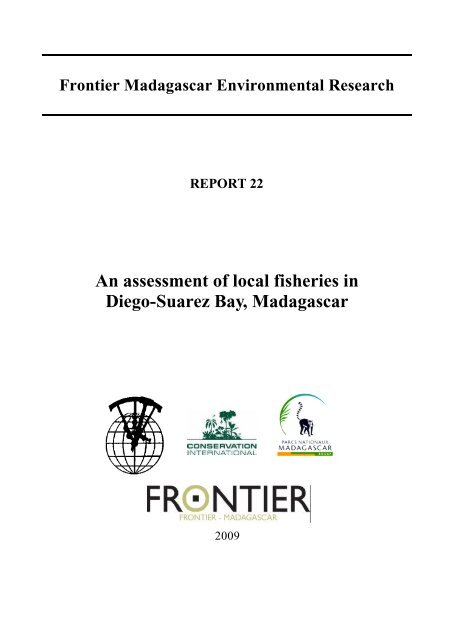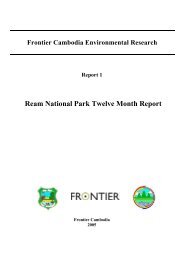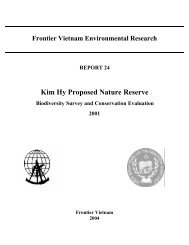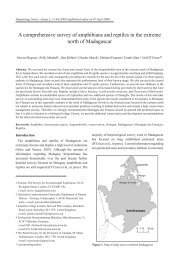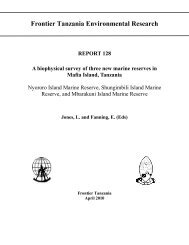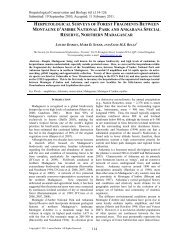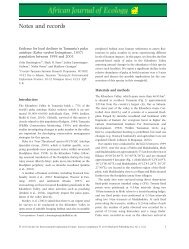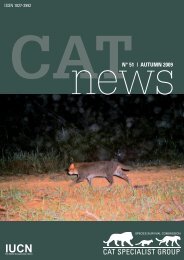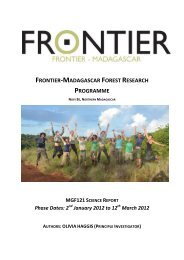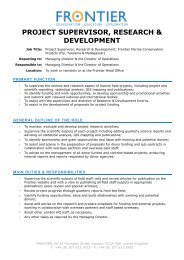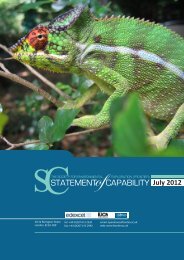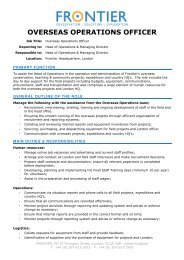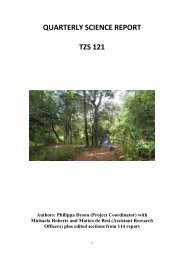An assessment of local fisheries in Diego-Suarez Bay, Madagascar
An assessment of local fisheries in Diego-Suarez Bay, Madagascar
An assessment of local fisheries in Diego-Suarez Bay, Madagascar
You also want an ePaper? Increase the reach of your titles
YUMPU automatically turns print PDFs into web optimized ePapers that Google loves.
Frontier <strong>Madagascar</strong> Environmental Research<br />
REPORT 22<br />
<strong>An</strong> <strong>assessment</strong> <strong>of</strong> <strong>local</strong> <strong>fisheries</strong> <strong>in</strong><br />
<strong>Diego</strong>-<strong>Suarez</strong> <strong>Bay</strong>, <strong>Madagascar</strong><br />
2009
Frontier <strong>Madagascar</strong> Environmental Research<br />
Report 22<br />
<strong>An</strong> <strong>assessment</strong> <strong>of</strong> <strong>local</strong> <strong>fisheries</strong> <strong>in</strong><br />
<strong>Diego</strong>-<strong>Suarez</strong> <strong>Bay</strong>, <strong>Madagascar</strong><br />
Narozanski, A. J., Steer, M. D. and Fann<strong>in</strong>g E. (eds.)<br />
ANGAP<br />
Conservation International<br />
<strong>Diego</strong> <strong>Suarez</strong><br />
2009<br />
Society for<br />
Environmental<br />
Exploration<br />
UK
Suggested Technical Paper citation:<br />
Frontier <strong>Madagascar</strong> (2009) <strong>An</strong> <strong>assessment</strong> <strong>of</strong> <strong>local</strong> <strong>fisheries</strong> <strong>in</strong> <strong>Diego</strong>-<strong>Suarez</strong> <strong>Bay</strong>,<br />
<strong>Madagascar</strong>. Narozanski, A. J., Steer, M. D. and Fann<strong>in</strong>g E. (eds.) Frontier <strong>Madagascar</strong><br />
Environmental Research Report 22. Society for Environmental Exploration, UK; ANGAP;<br />
Conservation International.<br />
The Frontier -<strong>Madagascar</strong> Environmental Research Report Series is published by:<br />
The Society for Environmental Exploration<br />
50-52 Riv<strong>in</strong>gton Street,<br />
London, EC2A 3QP<br />
United K<strong>in</strong>gdom<br />
Tel: +44 (0)20 7613 3061<br />
Fax: +44 (0)20 7613 2992<br />
E-mail: research@frontier.ac.uk<br />
Web Page: www.frontier.ac.uk<br />
ISSN 1479-120X (Pr<strong>in</strong>t)<br />
ISSN 1748-3719 (Onl<strong>in</strong>e)<br />
ISSN 1748-5126 (CD-ROM)<br />
© Frontier-<strong>Madagascar</strong> 2009<br />
iii
The National Association for the Management <strong>of</strong> Protected Areas <strong>in</strong> <strong>Madagascar</strong> (ANGAP)<br />
ANGAP (or The <strong>Madagascar</strong> National Parks Association) is a private association, established <strong>in</strong><br />
1990 to manage <strong>Madagascar</strong>'s network <strong>of</strong> protected areas. ANGAP promotes and manages nature<br />
conservation alongside responsible susta<strong>in</strong>able development, therefore ensur<strong>in</strong>g that <strong>local</strong><br />
communities benefit directly from conservation.<br />
Conservation International (CI)<br />
CI is a nonpr<strong>of</strong>it organization that seeks to protect Earth’s high-biodiversity wilderness and<br />
hotspots. The group is known for its partnerships with <strong>local</strong> non-governmental organizations and<br />
<strong>in</strong>digenous peoples, demonstrat<strong>in</strong>g that human societies are able to live harmoniously with<br />
nature. This mission is based around three guid<strong>in</strong>g pr<strong>in</strong>ciples <strong>of</strong> cutt<strong>in</strong>g-edge science,<br />
comprehensive partnerships, and concern for human well-be<strong>in</strong>g. S<strong>in</strong>ce 1987, CI have conserved<br />
over 143 million terrestrial acres and 80 million acres <strong>of</strong> mar<strong>in</strong>e area.<br />
The Society for Environmental Exploration (SEE)<br />
The Society is a non-pr<strong>of</strong>it mak<strong>in</strong>g company limited by guarantee and was formed <strong>in</strong> 1989. The<br />
Society’s objectives are to advance field research <strong>in</strong>to environmental issues and implement<br />
practical projects contribut<strong>in</strong>g to the conservation <strong>of</strong> natural resources. Projects organised by The<br />
Society are jo<strong>in</strong>t <strong>in</strong>itiatives developed <strong>in</strong> collaboration with national research agencies <strong>in</strong> cooperat<strong>in</strong>g<br />
countries.<br />
Frontier-<strong>Madagascar</strong> Mar<strong>in</strong>e Research Programme (FM MRP)<br />
The Society for Environmental Exploration (SEE) has been conduct<strong>in</strong>g research <strong>in</strong>to<br />
environmental issues s<strong>in</strong>ce 2000 under the title <strong>of</strong> Frontier-<strong>Madagascar</strong>. The Frontier-<br />
<strong>Madagascar</strong> Mar<strong>in</strong>e Research Programme conducts research <strong>in</strong>to biological diversity and<br />
resource utilisation <strong>of</strong> both mar<strong>in</strong>e and coastal environments, <strong>in</strong> <strong>Diego</strong>-<strong>Suarez</strong> <strong>Bay</strong>, <strong>in</strong><br />
collaboration with ANGAP, Conservation International, and IBIS.<br />
For more <strong>in</strong>formation:<br />
Frontier -<strong>Madagascar</strong><br />
BP41, <strong>An</strong>tsiranana, 201<br />
MADAGASCAR<br />
Tel/Fax: +261 (0) 20 82<br />
23117<br />
E-mail:<br />
frontier@wanadoo.mg<br />
Society for Environmental<br />
Exploration<br />
50-52 Riv<strong>in</strong>gton Street,<br />
London, EC2A 3QP. U.K.<br />
Tel: +44 (0) 20 7613 3061<br />
Fax: +44 (0) 20 7613 2992<br />
E-mail: research@frontier.ac.uk<br />
Internet: www.frontier.ac.uk<br />
iv
ACKNOWLEDGEMENTS<br />
This report is the culm<strong>in</strong>ation <strong>of</strong> the advice, co-operation, hard work and expertise <strong>of</strong> many people. In<br />
particular acknowledgements are due to the follow<strong>in</strong>g:<br />
THE NATIONAL ASSOCIATION FOR THE MANAGEMENT OF PROTECTED AREAS IN<br />
MADAGASCAR (ANGAP)<br />
Director <strong>of</strong> the Nosy Hara park Mr. Jaomanana<br />
CONSERVATION INTERNATIONAL (CI)<br />
Regional Director for Mar<strong>in</strong>e Projects : Ms. Monica Tombolahy<br />
SOCIETY FOR ENVIRONMENTAL EXPLORATION (SEE)<br />
Manag<strong>in</strong>g Director: Mrs. Eibleis Fann<strong>in</strong>g<br />
Research and Development Manager: Dr. Mark Steer<br />
Research and Development Officers: Ms. Elisabeth Wulffeld<br />
Ms. Olivia Couchman<br />
Mr. Leigh Richardson<br />
Mr. Robert Perryman<br />
FRONTIER-MADAGASCAR<br />
Country Co-ord<strong>in</strong>ator: Ms. Elizabeth Middleton<br />
Assistant Country Coord<strong>in</strong>ator: Ms. Chloe Searl<br />
Pr<strong>in</strong>cipal Investigator: Mr. <strong>An</strong>drzej Narozanski<br />
Research Officers: Ms. Alison Evans<br />
Ms. Vivienne Johnson<br />
Assistant Research Officers: Mr. Alex Leman-Lawrie<br />
Mr. <strong>An</strong>thony K<strong>in</strong>g<br />
Ms. Jennifer Wilmes<br />
Ms. Joanne Eaton<br />
Ms. Joseph<strong>in</strong>e Pegg<br />
Ms. Katie Cherry<br />
Mr. Michel Trommelen<br />
Dive Officer: Mr. Daniel Shultz<br />
Research Assistants:<br />
<strong>An</strong>nelies Vermeulen, Shireen Darabi, Katie Strange, Lucy sanders, <strong>An</strong>drew Derrick, Charlotte Vallily,<br />
Max Bodmer, Edward Sockett, Hannah Mold, Paul Codd, William Salter, Nicholas Marsden, Elspeth<br />
Esdon, Nick Riddiford, Sam Davies, Frances Blow, Penny <strong>An</strong>derson, Hugo Flaux, Alexander Critchley,<br />
Maia Sterenfeld, Julia Haywood, Miles Ramsden, Bryony Coll<strong>in</strong>s, Jennifer Allan, Laura Shearer, Robyn<br />
Smith, Joshua Lee, <strong>An</strong>na Chouler, Kate Bonham, Sarah-Jane Trehane, Gareth Wilmot, Benjam<strong>in</strong> Miles,<br />
Manto Konstanto, Alexander Smith, Joe Tuck, Luke Gordon, Z<strong>of</strong>ia Harries, Fran Bill<strong>in</strong>gsley<br />
Also thanks to the people <strong>of</strong> <strong>An</strong>tsisikala and Ramena, plus many thanks to the Malagasy <strong>in</strong>terpreters<br />
whose help was <strong>in</strong>valuable.<br />
v
Table <strong>of</strong> contents<br />
EXECUTIVE SUMMARY 2<br />
1 INTRODUCTION 3<br />
2 METHODS AND MATERIALS 4<br />
2.1 SURVEY AREA AND STUDY SECTORS 4<br />
2.2 SURVEY METHODS 4<br />
2.2.1 SOCIO-ECONOMIC DATA 5<br />
2.2.2 RESOURCE STATUS 5<br />
2.2.3 VISUAL OBSERVATIONS 5<br />
3 RESULTS 6<br />
3.1 SOCIO-ECONOMIC DATA 6<br />
3.2 RESOURCE STATUS AND VISUAL OBSERVATIONS 10<br />
3.2.1 LINE INTERCEPT TRANSECT (LIT) 10<br />
3.2.2 UNDERWATER VISUAL CENSUS (UVC) 10<br />
3.3 VISUAL OBSERVATIONS 12<br />
3.3.1 FISHING AREAS 12<br />
3.3.2 FISHING METHODS 13<br />
3.3.3 CATCH-PER-UNIT EFFORT 15<br />
3.3.4 DIEGO-SUAREZ FISH MARKET PRICES 15<br />
4 DISCUSSION 16<br />
4.1 SOCIO-ECONOMIC AND VISUAL OBSERVATIONS 16<br />
4.2 RESOURCE STATUS (UVC AND LIT) AND VISUAL OBSERVATIONS 19<br />
4.3 SUMMARY OF POSSIBLE CONSERVATION MANAGEMENT METHODS 20<br />
4.4 SUMMARY OF TOPICS FOR FUTURE STUDY 20<br />
5 CONCLUSION 21<br />
6 REFERENCES 22<br />
APPENDICES 24<br />
1
EXECUTIVE SUMMARY<br />
The artisanal fishery <strong>in</strong> <strong>Diego</strong>-<strong>Suarez</strong> <strong>Bay</strong>, north <strong>Madagascar</strong> is an active fishery where fishermen use<br />
multiple methods based on traditional techniques. Prior to this study there has been virtually no<br />
documented <strong>assessment</strong> <strong>of</strong> fish<strong>in</strong>g activity with<strong>in</strong> the bay. A total <strong>of</strong> forty fishermen from two important<br />
fish<strong>in</strong>g villages were <strong>in</strong>terviewed on fish<strong>in</strong>g practices, fish<strong>in</strong>g habits, economic considerations, <strong>local</strong><br />
perceptions on fish stocks, temporal changes and environmental awareness. Interview data was<br />
complemented with a direct <strong>in</strong>vestigation <strong>of</strong> reef health with respect to hard coral cover and fish stocks.<br />
The fishery targets multiple families <strong>of</strong> reef and reef associated fish as well as <strong>in</strong>vertebrates. Carangidae,<br />
Lutjanidae and Mullidae were the most common fish families targeted, us<strong>in</strong>g five pr<strong>in</strong>cipal fish<strong>in</strong>g<br />
techniques; hook and l<strong>in</strong>e, gill nets, se<strong>in</strong>e nets, spear guns and traps. There was a significant difference <strong>in</strong><br />
the catch sizes and the types <strong>of</strong> fish<strong>in</strong>g gear used between the two villages surveyed. Catch size and fish<br />
abundance was reported by the fishermen to have decreased <strong>in</strong> recent years. Fishermen op<strong>in</strong>ions ranged<br />
on the cause <strong>of</strong> this decrease, with no universal outstand<strong>in</strong>g answer given. The most likely explanation<br />
lies <strong>in</strong> <strong>in</strong>creased pressure on mar<strong>in</strong>e resources caused by the current steady rise <strong>in</strong> the <strong>local</strong> population and<br />
<strong>in</strong>creas<strong>in</strong>g tourism. Although the fishery is not currently <strong>in</strong> a bad state, productivity and susta<strong>in</strong>ability<br />
could be improved through education <strong>of</strong> <strong>local</strong>s and simple management strategies. The bay <strong>of</strong>fers a good<br />
opportunity for proactive conservation programmes to be implemented before large scale problems start<br />
to become manifest.<br />
2
1 Introduction<br />
S<strong>in</strong>ce ancient times, fish have constituted a major source <strong>of</strong> food for humans and fish<strong>in</strong>g has provided<br />
employment and economic benefits to those engaged <strong>in</strong> this activity. The wealth <strong>of</strong> mar<strong>in</strong>e resources was<br />
once assumed to be an unlimited gift <strong>of</strong> nature. However through <strong>in</strong>creased knowledge and the dynamic<br />
development <strong>of</strong> <strong>fisheries</strong> science post Second World War, this myth has faded <strong>in</strong> face <strong>of</strong> the realisation<br />
that aquatic resources, although renewable, are not <strong>in</strong>f<strong>in</strong>ite and need appropriate management<br />
(Keenleyside, 1997; Pauly, 2008).<br />
Fish<strong>in</strong>g is widely recognised as hav<strong>in</strong>g a major <strong>in</strong>fluence on mar<strong>in</strong>e ecosystems throughout the world.<br />
Industrial fish<strong>in</strong>g has been well documented to cause serious habitat degradation through benthic<br />
dredg<strong>in</strong>g and trawl<strong>in</strong>g (Watl<strong>in</strong>g & Norse, 1998) and over-exploitation <strong>of</strong> species (Myers et al., 1997).<br />
Artisanal <strong>fisheries</strong>, by comparison, operate on a smaller scale and tend to be associated with relatively<br />
low environmental impacts (Hawk<strong>in</strong>s & Roberts, 2004; Dalzell, 1998). These <strong>fisheries</strong> are near-shore and<br />
exploited by small-scale fishers us<strong>in</strong>g labour <strong>in</strong>tensive methods with little or no modern technology.<br />
Typically the people carry<strong>in</strong>g out these activities are part-time, subsistence fishers who use a multiple <strong>of</strong><br />
fish<strong>in</strong>g techniques to target multiple species. In the Pacific, artisanal <strong>fisheries</strong> have been documented to<br />
have had no significant impact on the state <strong>of</strong> coral reef ecosystems despite constant use over the last<br />
thousand years (Dalzell, 1998). However, this f<strong>in</strong>d<strong>in</strong>g is contradicted by numerous other studies<br />
highlight<strong>in</strong>g the negative impacts artisanal <strong>fisheries</strong> can have on reef systems and fish biomass (e.g.<br />
Adam et al., 1997; Colbentz, 1997). Despite their perceived impacts, artisanal <strong>fisheries</strong> are especially<br />
important <strong>in</strong> develop<strong>in</strong>g countries, throughout the tropics <strong>in</strong> particular. <strong>An</strong> estimated annual yield <strong>of</strong> six<br />
million tonnes per year is harvested from tropical coral reefs (Munro, 1996), <strong>in</strong>dicat<strong>in</strong>g their importance<br />
for <strong>local</strong> peoples.<br />
Few methodological modifications have been implemented <strong>in</strong> the world’s artisanal <strong>fisheries</strong> over the last<br />
few centuries; the <strong>in</strong>troduction <strong>of</strong> motorised boats and modern materials (such as nylon filament l<strong>in</strong>es and<br />
artificial bait) be<strong>in</strong>g the ma<strong>in</strong> changes (Hawk<strong>in</strong>s & Roberts, 2004). What has changed, however, is the<br />
<strong>in</strong>crease <strong>in</strong> the number <strong>of</strong> people be<strong>in</strong>g supported by these <strong>fisheries</strong>. The number <strong>of</strong> artisanal <strong>fisheries</strong> <strong>in</strong><br />
develop<strong>in</strong>g countries has <strong>in</strong>creased significantly <strong>in</strong> recent years, driven by <strong>in</strong>creas<strong>in</strong>g coastal populations<br />
(FAO 2000). Documented impacts <strong>in</strong>clude the reduction <strong>in</strong> life expectancies <strong>of</strong> certa<strong>in</strong> specie s (Munro,<br />
1983), elim<strong>in</strong>ation <strong>of</strong> species from reef areas (Wells, 1997), long-term reef degradation (G<strong>in</strong>sburg et al.,<br />
1994) and the mass depletion <strong>in</strong> targeted genera (Koslow et al., 1994). Typical <strong>of</strong> many subsistence and<br />
traditional forms <strong>of</strong> renewable resource use, over-exploitation can result <strong>in</strong> irreversible economic, social<br />
and cultural harm to the very people caus<strong>in</strong>g the damage (Tundi, 2000).<br />
<strong>Diego</strong>-<strong>Suarez</strong> <strong>Bay</strong>, situated <strong>in</strong> the far north <strong>of</strong> <strong>Madagascar</strong>, has a thriv<strong>in</strong>g fish<strong>in</strong>g <strong>in</strong>dustry about which<br />
little is known. The bay has numerous sub-bays, which present a range <strong>of</strong> tropical habitats (coral reef, sea<br />
grass and mangrove). These habitats are an important resource and support neighbour<strong>in</strong>g villages with<br />
reef <strong>fisheries</strong>. Artisanal fish<strong>in</strong>g methods us<strong>in</strong>g traditional techniques with modern material are used daily<br />
throughout the bay. Due to a variety <strong>of</strong> terrestrial and anthropogenic <strong>in</strong>fluences the bay exhibits a wide<br />
range <strong>in</strong> the quality <strong>of</strong> its reefs, <strong>in</strong> terms <strong>of</strong> coral cover, fish diversity and fish biomass.<br />
This report assesses the state <strong>of</strong> the fishery, through describ<strong>in</strong>g the methods and materials used by the<br />
fishermen, ga<strong>in</strong><strong>in</strong>g <strong>local</strong> op<strong>in</strong>ion, identify<strong>in</strong>g environmental impacts, and assess<strong>in</strong>g catch data. We<br />
recommend that proactive conservation programmes should be implemented to ensure the susta<strong>in</strong>ability<br />
<strong>of</strong> the <strong>local</strong> <strong>fisheries</strong>.<br />
3
2 Methods and Materials<br />
2.1 Survey area and study sectors<br />
The study took place from July 2005 to December 2008 around <strong>Diego</strong>-<strong>Suarez</strong> <strong>Bay</strong>, Northern <strong>Madagascar</strong>.<br />
<strong>Diego</strong>-<strong>Suarez</strong> <strong>Bay</strong> is a shallow tropical bay (mean depth 30m), open to the Indian Ocean <strong>in</strong> the east. The<br />
<strong>in</strong>terior <strong>of</strong> the bay is characterised by numerous small islands or Nosy(s) as they are known <strong>in</strong> Malagasy,<br />
and a coastl<strong>in</strong>e l<strong>in</strong>ed with many, almost cont<strong>in</strong>uous, shallow fr<strong>in</strong>g<strong>in</strong>g reefs. The bay has been divided <strong>in</strong>to<br />
study sectors and islands to enable long-term monitor<strong>in</strong>g by SEE Frontier <strong>Madagascar</strong> (figure 1). Each<br />
sector/island has been further divided <strong>in</strong>to study sites (rang<strong>in</strong>g from 2-26 sites per sector/island) with each<br />
site be<strong>in</strong>g a maximum <strong>of</strong> 300m apart from each other. Ramena is a small fish<strong>in</strong>g village west <strong>of</strong> the<br />
mouth <strong>of</strong> the bay (figure 1), which is popular with tourists. Fish<strong>in</strong>g is the ma<strong>in</strong> activity for <strong>local</strong>s <strong>in</strong> this<br />
village, with some fishermen cater<strong>in</strong>g for tourist excursions as well. <strong>An</strong>tsisikala <strong>in</strong> the north <strong>of</strong> the bay<br />
(figure 1) is a small village with approximately 50 houses. They generate the majority <strong>of</strong> their <strong>in</strong>come<br />
through zebu farm<strong>in</strong>g, while fish<strong>in</strong>g is pr<strong>in</strong>cipally for subsistence and small-scale trad<strong>in</strong>g.<br />
Figure 1. Map <strong>of</strong> <strong>Diego</strong>-<strong>Suarez</strong> <strong>Bay</strong>, display<strong>in</strong>g 11 designated study sectors and islands<br />
2.2 Survey Methods<br />
To fulfil the objectives <strong>of</strong> the study, four survey methods were used:<br />
• Questionnaires to ga<strong>in</strong> <strong>in</strong>formation on the current status <strong>of</strong> the fishery and fishermen’s op<strong>in</strong>ions.<br />
• L<strong>in</strong>e Intercept Transect (LIT) to determ<strong>in</strong>e the percentage <strong>of</strong> hard coral cover at each study site<br />
(part <strong>of</strong> a SEE Frontier long-term monitor<strong>in</strong>g project).<br />
• Underwater Visual Census (UVC) to calculate the biomass <strong>of</strong> fish at each site (part <strong>of</strong> a SEE<br />
Frontier long-term monitor<strong>in</strong>g project).<br />
• Visual observations <strong>of</strong> artisanal fish<strong>in</strong>g effort, techniques used and species targeted.<br />
4
2.2.1 Socio-economic data<br />
A total <strong>of</strong> 21 fishermen were <strong>in</strong>terviewed from the village <strong>An</strong>tsisikala (figure 1) on two separate<br />
occasions <strong>in</strong> November 2006 and then <strong>in</strong> August 2008 and n<strong>in</strong>eteen fishermen were <strong>in</strong>terviewed <strong>in</strong><br />
Ramena (figure 1) <strong>in</strong> December 2006. The questionnaires consisted <strong>of</strong> 25 questions (Appendix 8.1) and<br />
each <strong>in</strong>terview was conducted us<strong>in</strong>g a Malagasy <strong>in</strong>terpreter last<strong>in</strong>g approximately 40 m<strong>in</strong>utes. Questions<br />
centred on fish<strong>in</strong>g practices, fish<strong>in</strong>g habits, economic considerations, <strong>local</strong> perceptions on fish stocks,<br />
temporal changes and environmental awareness. The estimated catch per unit effort (CPUE) value was<br />
calculated <strong>in</strong> (kg per man/h) us<strong>in</strong>g <strong>in</strong>formation on catch weight and time-spent fish<strong>in</strong>g for each type <strong>of</strong><br />
equipment.<br />
2.2.2 Resource status<br />
The L<strong>in</strong>e Intercept Transect (LIT) method was used to calculate percentage cover <strong>of</strong> hard coral genera at<br />
a given survey site. The length <strong>of</strong> each benthic substratum, found directly underneath a 20m transect l<strong>in</strong>e<br />
was recorded (<strong>in</strong> cms). If the substrate was hard coral, it was recorded to genus level. Data collected us<strong>in</strong>g<br />
the LIT method was collected between July 2005 and September 2008. Spearman’s rank correlations<br />
were calculated to determ<strong>in</strong>e relationships between fish<strong>in</strong>g activity and fish biomass, fish diversity and<br />
hard coral cover.<br />
To assess fish species diversity and biomass at a given survey site the Underwater Visual Census (UVC)<br />
technique was used. The size and frequency <strong>of</strong> fish encountered with<strong>in</strong> an area 2.5 m on either side and 5<br />
m above a 20m transect was recorded. The size <strong>of</strong> any fish enter<strong>in</strong>g this space was estimated to the<br />
nearest 5cm and recorded on a specially designed slate. Species recorded were <strong>in</strong> the families: Lethr<strong>in</strong>idae<br />
(emperors), Lutjanidae (snappers), Labridae (wrasse), Serranidae (groupers), Mullidae (goatfish),<br />
Siganidae (rabbitfish), Haemulidae (sweetlips), Balistidae (triggerfish, Acanthuridae (surgeonfish),<br />
Carangidae (jacks and trevallies), Dasyatidae (st<strong>in</strong>grays), Holocentridae (squirrelfish and soliderfish),<br />
Apogonidae (card<strong>in</strong>alfish), Caesionidae (fusiliers), Nemipteridae (monocle breams and sp<strong>in</strong>e cheeks),<br />
Chaetodontidae (butterflyfish), Pomacanthidae (angelfish), Pomacentridae (damselfish), Scaridae<br />
(parrotfish), Scrombridae, (mackerel) Lethr<strong>in</strong>idae (emperors) and Sphyraenidae (barracuda). Data<br />
collected us<strong>in</strong>g the UVC method is available between July 2005 and December 2008 for all sectors and<br />
islands.<br />
The number <strong>of</strong> LIT and UVC surveys carried out dur<strong>in</strong>g this time <strong>in</strong> each sector or island is as follows;<br />
Nosy Fano=29, Nosy Koba=34, Ramena=8, Nosy Langoro=12, Nosy Loapasana=14, Nosy Volana=5,<br />
Sector 0=63, Sector 1=46, Sector 2=74, Sector 3=67, Sector 4=71, Sector 5=68, Sector 6=22, Sector<br />
7=14, Sector 8=19, Sector 9=2, Sector 10=4, Sector 11=9 (a total <strong>of</strong> 561). Dur<strong>in</strong>g January to December<br />
2008 the follow<strong>in</strong>g number <strong>of</strong> surveys were carried out; Nosy Fano =12, Nosy Koba=22, Nosy<br />
Langoro=6, Sector 0=21, Sector 1=15, Sector 2=32, Sector 3=33, Sector 4=21, Sector 5=12 (a total <strong>of</strong><br />
175). See Frontier-<strong>Madagascar</strong> (2003) for more details on the LIT and UVC methods.<br />
2.2.3 Visual Observations<br />
Dur<strong>in</strong>g UVC and LIT surveys, systematic observations were made concern<strong>in</strong>g levels <strong>of</strong> coral damage<br />
caused by fish<strong>in</strong>g activity, fish species caught <strong>in</strong> nets or on l<strong>in</strong>es by fishermen, types <strong>of</strong> gear used and<br />
materials, number <strong>of</strong> fishers <strong>in</strong>volved <strong>in</strong> fish<strong>in</strong>g activities, plus any additional relevant <strong>in</strong>formation<br />
observed dur<strong>in</strong>g fish<strong>in</strong>g activity. The presence and number <strong>of</strong> fish<strong>in</strong>g boats was also noted at each site<br />
before and after the UVC and LIT surveys were performed. Data was collected between July 2005 and<br />
December 2008 for all sectors and islands. <strong>An</strong> estimated CPUE value was calculated <strong>in</strong> (kg per man/h) on<br />
observations made dur<strong>in</strong>g fish<strong>in</strong>g activity. Us<strong>in</strong>g mean weight <strong>of</strong> catch, gear used and time spent fish<strong>in</strong>g<br />
per day, where available from the questionnaires or observed dur<strong>in</strong>g fish<strong>in</strong>g activity, an estimated CPUE<br />
value has been calculated.<br />
5
3 Results<br />
3.1 Socio-economic data<br />
Percentage <strong>of</strong> fishermen<br />
50<br />
45<br />
40<br />
35<br />
30<br />
25<br />
20<br />
15<br />
10<br />
5<br />
0<br />
fish<strong>in</strong>g subsistence transport moral<br />
obligation<br />
Primary <strong>in</strong>terest <strong>in</strong> the bay<br />
Figure 2. Ma<strong>in</strong> <strong>in</strong>terest <strong>of</strong> fishermen <strong>in</strong> <strong>Diego</strong>-<strong>Suarez</strong> <strong>Bay</strong> (n=27)<br />
Number <strong>of</strong> fishermen<br />
16<br />
14<br />
12<br />
10<br />
8<br />
6<br />
4<br />
2<br />
0<br />
Carangidae (Jacks)<br />
Lutjanidae<br />
Mullidae<br />
Scaridae<br />
Siganidae<br />
Lethr<strong>in</strong>idae<br />
Serranidae<br />
Acanthuridae<br />
Labridae<br />
Haemulidae<br />
Carangidae (Trevallies)<br />
aesthetics<br />
aethestic religious conservation tourism<br />
Caesionidae<br />
Pomacanthidae<br />
Carcharh<strong>in</strong>idae<br />
Fish / <strong>in</strong>vertebrate families<br />
Octopodidae<br />
Scrombridae (Mackerel)<br />
Scrombridae (Tuna)<br />
Holothuria spp.<br />
Figure 3. Pr<strong>in</strong>cipal fish/<strong>in</strong>vertebrate families targeted by fishermen <strong>in</strong> <strong>Diego</strong>-<strong>Suarez</strong> <strong>Bay</strong> (n=21). Carangidae<br />
and Scrombridae have been subdivided to differentiate between the two ma<strong>in</strong> genre targeted with<strong>in</strong> those<br />
families<br />
Fish<strong>in</strong>g, subsistence and transport are the three pr<strong>in</strong>cipal <strong>in</strong>terests <strong>in</strong> <strong>Diego</strong>-<strong>Suarez</strong> <strong>Bay</strong> accord<strong>in</strong>g to<br />
fishermen <strong>in</strong>terviewed (figure 2). Conservation <strong>of</strong> the bay and its resources was considered to be the ma<strong>in</strong><br />
Balistidae<br />
Dasyatidae<br />
Sphyraenidae<br />
6
<strong>in</strong>terest <strong>in</strong> the bay by three fishermen (9%). Moral obligation, aesthetic value, religious value and tourism<br />
were not considered to be important by any <strong>of</strong> the fisherman.<br />
Target<strong>in</strong>g multiple families was common among fishermen with 80% target<strong>in</strong>g three or more. Fish<strong>in</strong>g <strong>in</strong><br />
<strong>Diego</strong>-<strong>Suarez</strong> <strong>Bay</strong> targets the highest trophic level <strong>of</strong> coral reef fish, with 57% <strong>of</strong> the targeted species<br />
be<strong>in</strong>g piscivores and macro<strong>in</strong>vertebrate feeders. Carangidae (Jacks), Lutjanidae and Mullidae were the<br />
most sought after families, followed by Scaridae, Siganidae, Lethr<strong>in</strong>idae, Serranidae and Acanthuridae<br />
(figure 3).<br />
Percentage <strong>of</strong> fishermen<br />
100<br />
90<br />
80<br />
70<br />
60<br />
50<br />
40<br />
30<br />
20<br />
10<br />
0<br />
Common<br />
fish<br />
Highest<br />
<strong>in</strong>come<br />
Gear People like<br />
these fish<br />
Reason for target<strong>in</strong>g fish<br />
Figure 4. Fishermen’s reasons for target<strong>in</strong>g fish species (n=40)<br />
Percentage <strong>of</strong> fishermen<br />
100<br />
90<br />
80<br />
70<br />
60<br />
50<br />
40<br />
30<br />
20<br />
10<br />
0<br />
Fish<strong>in</strong>g<br />
net<br />
Se<strong>in</strong>e net Spear gun Hook and<br />
l<strong>in</strong>e<br />
Fish<strong>in</strong>g Gear Used<br />
Used to<br />
catch<strong>in</strong>g<br />
this<br />
species<br />
Poison Trap<br />
Figure 5. Percentage <strong>of</strong> fishermen us<strong>in</strong>g each type <strong>of</strong> fish<strong>in</strong>g gear (n= 40)<br />
Fishermen targeted fish pr<strong>in</strong>cipally due the fish be<strong>in</strong>g common and widely available. Income and the<br />
availability <strong>of</strong> gear were less important. Few fishermen targeted fish because they are what people like to<br />
eat. Other reasons <strong>in</strong>cluded target<strong>in</strong>g species because they are considered to be large spawners, as well as,<br />
target<strong>in</strong>g certa<strong>in</strong> species allows others to thrive<br />
The mean number <strong>of</strong> days spent fish<strong>in</strong>g per week is four, with 33% <strong>of</strong> fishermen fish<strong>in</strong>g every day dur<strong>in</strong>g<br />
the week. Monday (16%) and Sunday (11%) were the two most popular <strong>in</strong>dividual days to go out fish<strong>in</strong>g,<br />
7<br />
Other
ut the majority <strong>of</strong> fishermen do not have a specific day, fish<strong>in</strong>g on any day <strong>of</strong> the week (44%). The<br />
number <strong>of</strong> hours spent fish<strong>in</strong>g ranged from one to twelve hours per day, with a mean <strong>of</strong> five hours.<br />
The months around the turn <strong>of</strong> the year (November, December, January and February) were the most<br />
favourable months <strong>in</strong> which to fish with December be<strong>in</strong>g the most popular (11%).<br />
The most common types <strong>of</strong> fish<strong>in</strong>g gear used were the fish<strong>in</strong>g net and a hook and l<strong>in</strong>e (figure 5). There<br />
was a significant difference <strong>in</strong> the types <strong>of</strong> gear used by fishermen <strong>in</strong> Ramena and those <strong>in</strong>terviewed from<br />
<strong>An</strong>tsisikala. Chi-square cont<strong>in</strong>gency tests us<strong>in</strong>g the total frequency counts for each fishermen us<strong>in</strong>g each<br />
gear from Ramena or from <strong>An</strong>tsisikala showed there is an association between gear use and where the<br />
fishermen came from. (χ 2 = 14.97, df = 5, p < 0.010). Se<strong>in</strong>e nett<strong>in</strong>g was used by 56% <strong>of</strong> the fishermen <strong>in</strong><br />
Ramena, compared to none <strong>of</strong> fishermen from <strong>An</strong>tsisikala. Accord<strong>in</strong>g to 92% <strong>of</strong> fishermen, fish<strong>in</strong>g<br />
techniques had not changed <strong>in</strong> the years that they had been fish<strong>in</strong>g.<br />
Percentage <strong>of</strong> fishermen<br />
100<br />
90<br />
80<br />
70<br />
60<br />
50<br />
40<br />
30<br />
20<br />
10<br />
0<br />
yes when fish<br />
too small<br />
yes when fish<br />
is non-target<br />
yes when its<br />
not a valuable<br />
species<br />
not good to<br />
eat<br />
Reason for throw<strong>in</strong>g fish back<br />
Figure 6. Reason for throw<strong>in</strong>g fish back (n=36)<br />
do not throw<br />
anyth<strong>in</strong>g back<br />
Seventy-two percent <strong>of</strong> the fishermen would throw fish back while 28% would not. Of the 72% that said<br />
yes, 67% <strong>of</strong> fishermen throw fish back if they are too small, 31% if they are non-target species, 14% if<br />
they not valuable and 0% throw fish back if they are not good to eat.<br />
The majority <strong>of</strong> fishermen reported a mean daily catch weight between 1-25kg (77%). With<strong>in</strong> this size<br />
class the weights varied from 2kg to 25kg. Weight classes 25-49kg and 50-75kg had a lower frequency<br />
(both 10%). However, there was a significantly higher frequency <strong>of</strong> catches from the weight classes 25-<br />
49kg and 50-75kg by fishermen from Ramena, than from <strong>An</strong>tsisikala (χ 2 = 8.53, df = 3, p < 0.036).<br />
8
10%<br />
10% 3%<br />
77%<br />
1-24kg<br />
25-49kg<br />
50-75kg<br />
> 75 kg<br />
Figure 7. Percentage <strong>of</strong> fishermen report<strong>in</strong>g daily catch weight <strong>in</strong> four size classes (n=40)<br />
Sell<strong>in</strong>g <strong>of</strong> a catch depended ma<strong>in</strong>ly on the size <strong>of</strong> the catch accord<strong>in</strong>g to 41% <strong>of</strong> the fishermen<br />
<strong>in</strong>terviewed, 22% said they would sell it every 2 to 3 days. Only 9% <strong>of</strong> fishermen chose not to sell their<br />
catch at all, fish<strong>in</strong>g only for subsistence. The city <strong>of</strong> <strong>Diego</strong>-<strong>Suarez</strong> was the most popular place to sell fish<br />
(54% <strong>of</strong> fishermen) and <strong>An</strong>tsisikala the second (31%).<br />
Table 1. Fishermen’s op<strong>in</strong>ion <strong>of</strong> the state <strong>of</strong> fish resources <strong>in</strong> <strong>Diego</strong>-<strong>Suarez</strong> <strong>Bay</strong> (n=40)<br />
Fish Resources Decreased (%) No change (%) Increased (%) Don't know (%)<br />
Catch size 58 38 3 3<br />
Abundance 83 13 3 3<br />
Average size 40 55 3 3<br />
Table 2. Fishermen’s op<strong>in</strong>ion <strong>of</strong> the reason for change <strong>in</strong> fish resources <strong>in</strong> <strong>Diego</strong>-<strong>Suarez</strong> <strong>Bay</strong> (n=39)<br />
Reason for change % fishermen<br />
More fisherman 13<br />
Effects <strong>of</strong> climate change 10<br />
Seasonal 8<br />
Bigger octopus mov<strong>in</strong>g to deeper sea 8<br />
Use <strong>of</strong> Se<strong>in</strong>e nets by fishermen <strong>in</strong> Ramena 5<br />
Overfish<strong>in</strong>g 5<br />
Coral damage through spear fish<strong>in</strong>g techniques 3<br />
Less ra<strong>in</strong> has led to more fish<strong>in</strong>g <strong>in</strong>stead <strong>of</strong> farm<strong>in</strong>g 3<br />
Other 5<br />
I don't know 10<br />
The majority <strong>of</strong> fishermen have perceived a recent decl<strong>in</strong>e <strong>in</strong> both catch size and abundance, whilst the<br />
average size <strong>of</strong> fish caught was reported to have stayed the same. Very few fishermen perceived that there<br />
had been any <strong>in</strong>crease <strong>in</strong> catch size, abundance or average size (table 1). There was no common answer to<br />
why fish catch had changed. <strong>An</strong>swers were split among the n<strong>in</strong>e ma<strong>in</strong> categories (table 2). The highest<br />
response given was an <strong>in</strong>crease <strong>in</strong> fishermen caus<strong>in</strong>g the decl<strong>in</strong>e, followed by the effects <strong>of</strong> climate<br />
change. A number <strong>of</strong> fishermen expla<strong>in</strong>ed climate change hav<strong>in</strong>g caused the seasons to become more<br />
unreliable and difficult to predict. Ten percent could give no reason for why there has been a change.<br />
9
Table 3. Fishermen’s op<strong>in</strong>ion on resource use <strong>in</strong> <strong>Diego</strong>-<strong>Suarez</strong> <strong>Bay</strong> (n=40)<br />
Question<br />
Fish<strong>in</strong>g should be restricted to specific areas 22 28 11 39 0<br />
Use fish<strong>in</strong>g nets with > 4 cm mesh 33 44 17 6 0<br />
Communities should work together on resource use 39 39 11 11 0<br />
Deforestation <strong>in</strong> coastal areas should be stopped 50 39 0 6 6<br />
Only catch large fish 50 44 6 0 0<br />
Do noth<strong>in</strong>g specific, there is enough fish 0 56 6 33 6<br />
Fish on certa<strong>in</strong> days 22 61 6 6 6<br />
A fisherman should decide himself how much fish he catches 22 56 11 11 0<br />
Pray or ask ancestors for more fish 11 44 28 17 0<br />
The government <strong>in</strong> <strong>Diego</strong> should control fish catch size 6 33 33 17 11<br />
Eat less fish 33 17 33 6 11<br />
Only catch certa<strong>in</strong> fish species 17 39 28 17 0<br />
Village chief should control the size <strong>of</strong> fish catches 28 56 11 0 6<br />
Get more tourists to the bay as an alternative source <strong>of</strong> <strong>in</strong>come 39 44 6 11 0<br />
In response to whether fish<strong>in</strong>g has an impact on the environment 78% <strong>of</strong> fishermen said it did have an<br />
impact and 28% said it had no impact. The majority <strong>of</strong> fishermen stated that there were fadys associated<br />
with fish<strong>in</strong>g <strong>in</strong> <strong>Diego</strong>-<strong>Suarez</strong> <strong>Bay</strong> (71%).<br />
Responses to questions on how best to ensure the availability <strong>of</strong> mar<strong>in</strong>e resources for future generations<br />
varied with no outstand<strong>in</strong>g universal answer for each question (table 3). The majority <strong>of</strong> people strongly<br />
agreed that deforestation <strong>in</strong> coastal areas should be stopped and only large fish should be caught. The<br />
greater part <strong>of</strong> fishermen agreed that: fish<strong>in</strong>g nets with > 4 cm mesh should be used; noth<strong>in</strong>g specific<br />
should be done as there is enough fish; only go out fish<strong>in</strong>g on certa<strong>in</strong> days; a fisherman should decide<br />
himself how much fish he catches; pray or ask ancestors for more fish; only certa<strong>in</strong> fish species should be<br />
caught; the village chief should control the size <strong>of</strong> fish catches, communities should work together on<br />
resource use and more tourists should be taken to the bay as an alternative source <strong>of</strong> <strong>in</strong>come. Most<br />
disagreed that fish<strong>in</strong>g should be restricted to specific areas. There was a split majority op<strong>in</strong>ion on two<br />
questions: 1. The government <strong>in</strong> <strong>Diego</strong> should control fish catch size (33% agree and neutral) and 2. Eat<br />
less fish (33% strongly agree and neutral), eat<strong>in</strong>g more zebu (a species <strong>of</strong> domestic tropical cattle) was<br />
mentioned by some fishermen as an alternative.<br />
3.2 Resource Status and visual observations<br />
3.2.1 L<strong>in</strong>e Intercept Transect (LIT)<br />
The relationship between mean hard coral cover and number <strong>of</strong> fish<strong>in</strong>g vessels at each sector (figure 8)<br />
was tested us<strong>in</strong>g Spearman’s rank correlation coefficient. There was no association between hard coral<br />
cover and number <strong>of</strong> fish<strong>in</strong>g vessels (rs = 0.414, n=17, p > 0.05).<br />
3.2.2 Underwater Visual Census (UVC)<br />
Spearman’s rank correlation coefficient was also used to test if there was an association between mean<br />
fish biomass vs. number <strong>of</strong> fish<strong>in</strong>g vessels, mean fish species richness vs. number <strong>of</strong> fish<strong>in</strong>g vessels and<br />
mean number <strong>of</strong> fish counted vs. number <strong>of</strong> fish<strong>in</strong>g vessels (fish biomass, mean fish species richness and<br />
mean number <strong>of</strong> fish counted data only available from January 2008 to December 2008 for sectors 0-5,<br />
Nosy Fano, Nosy Koba and Nosy Langoro). There was an association between mean fish biomass vs.<br />
number <strong>of</strong> fish<strong>in</strong>g vessels (rs = 0.708, n = 9, p < 0.05) (figure 9). However no association was found for<br />
the other two tests (fish species richness vs. number <strong>of</strong> fish<strong>in</strong>g vessels, rs = 0.225, n = 9, p > 0.05; mean<br />
number <strong>of</strong> fish counted vs. number <strong>of</strong> fish<strong>in</strong>g vessels rs = 0.225, n = 9, p > 0.05).<br />
Strongly<br />
agree<br />
Agree<br />
Neutral<br />
Disagree<br />
Strongly<br />
disagree<br />
10
Mean % hard coral cover<br />
30<br />
25<br />
20<br />
15<br />
10<br />
5<br />
0<br />
0 10 20 30 40<br />
Number <strong>of</strong> vessels recorded<br />
Figure 8. Relationship between mean hard coral cover and number <strong>of</strong> fish<strong>in</strong>g vessels recorded <strong>in</strong> sectors 0-11,<br />
Nosy Fano, Nosy Koba, Ramena, Nosy Langoro, Nosy Loapasana) from July 2005 to December 2008<br />
Mean fish biomass (g/100m)<br />
7000<br />
6000<br />
5000<br />
4000<br />
3000<br />
2000<br />
1000<br />
0<br />
0 10 20 30 40<br />
Number <strong>of</strong> vessels recorded<br />
Figure 9. Relationship between mean fish biomass (from January 2008 to December 2008) and number <strong>of</strong><br />
vessels recorded at sectors 0-5, Nosy Fano, Nosy Koba, Nosy Langoro (July 2005 to December 2008). Dark<br />
l<strong>in</strong>e <strong>in</strong>dicates l<strong>in</strong>ear trendl<strong>in</strong>e<br />
11
Mean number <strong>of</strong> fish<br />
14<br />
12<br />
10<br />
8<br />
6<br />
4<br />
2<br />
0<br />
0-5<br />
6-10<br />
11-15<br />
16-20<br />
21-25<br />
26-30<br />
31-35<br />
Size class (cm)<br />
Figure 10. Mean number <strong>of</strong> all fish (families and sectors comb<strong>in</strong>ed) recorded dur<strong>in</strong>g a s<strong>in</strong>gle UVC survey,<br />
found <strong>in</strong> each size class (data from July 2005 to December 2008)<br />
Fish <strong>of</strong> small size were relatively commonly recorded dur<strong>in</strong>g UVC surveys. The frequency <strong>of</strong> <strong>in</strong>dividuals<br />
<strong>in</strong> each size class decreases rapidly. The larger species (>20cm) that are more likely to be targeted by<br />
fishermen were found at low frequencies (figure 10).<br />
3.3 Visual Observations<br />
3.3.1 Fish<strong>in</strong>g areas<br />
The number <strong>of</strong> fish<strong>in</strong>g vessels recorded at each survey site <strong>in</strong> each sector <strong>of</strong> the bay before and after the<br />
UVC and LIT surveys were used to identify popular fish<strong>in</strong>g sites (figure 11). Sectors 0, 4, 5 and Ramena<br />
had the largest number <strong>of</strong> fish<strong>in</strong>g vessels present.<br />
36-40<br />
41-45<br />
46-50<br />
51+<br />
12
Figure 11. Map <strong>of</strong> <strong>Diego</strong>-<strong>Suarez</strong> <strong>Bay</strong>, light grey shaded areas <strong>in</strong>dicate popular fish<strong>in</strong>g sites. Dark grey area<br />
represents the urban conurbations <strong>of</strong> <strong>Diego</strong> <strong>Suarez</strong><br />
3.3.2 Fish<strong>in</strong>g methods<br />
Ramena<br />
Larger scale fish<strong>in</strong>g and more labour <strong>in</strong>tensive methods were observed <strong>in</strong> this area <strong>of</strong> the bay.<br />
Beach se<strong>in</strong>e nets are commonly used. They are made up <strong>of</strong> a s<strong>in</strong>gle-panel surround net consist<strong>in</strong>g <strong>of</strong> a bag<br />
<strong>in</strong> the middle to hold the catch, a shoulder section at each side and a w<strong>in</strong>g section at each end. The top <strong>of</strong><br />
the net has a floated headl<strong>in</strong>e made <strong>of</strong> plastic buoys, polystyrene floats and plastic bottles and the bottom<br />
is attached to a lightly weighted sole rope. Each w<strong>in</strong>g end is connected to a haul<strong>in</strong>g rope. The lengths <strong>of</strong><br />
the nets are approximately 200m. The mesh size varies from 1-3cm as the net is made up <strong>of</strong> many pieces<br />
<strong>of</strong> different nets. Towards the back <strong>of</strong> the net and at the cod end the nets are made up <strong>of</strong> a net with a mesh<br />
size as small as 1cm.<br />
The nets are cast parallel to the shore us<strong>in</strong>g boats, approximately 100m from the beach. The number <strong>of</strong><br />
fishermen on the boat lay<strong>in</strong>g out the net, ranges from 6-10. The haul<strong>in</strong>g ropes are brought ashore and the<br />
nets are pulled <strong>in</strong>to shore. Three to four men with snorkell<strong>in</strong>g equipment are placed <strong>in</strong> the water around<br />
the net, aggressively hitt<strong>in</strong>g the surface <strong>of</strong> the water to herd the fish <strong>in</strong>to the net. This process lasts up to<br />
an hour with as many as 18 people observed assist<strong>in</strong>g. Once the catch is pulled <strong>in</strong>, it is dumped on to the<br />
sand and then sorted <strong>in</strong>to species and placed <strong>in</strong>to plastic baskets and washed. The species caught were<br />
identified as sprat (Spratelloides delicatulus), great barracuda (Sphyraena barracuda), sard<strong>in</strong>es (species<br />
unknown), sky emperor (Lethr<strong>in</strong>us mahsena), blackspot emperor (Letrhr<strong>in</strong>us harak), dusky rabbitfish<br />
(Siganus fuscescens), half beaks (Hemiramphus far), cornetfish (Fistularia commersonii), white-spotted<br />
puffer (Arothron hispidus), longhorn cowfish (Lactoria cornuta ), three-ribbon wrasse (Stethojulis<br />
strigiventer).<br />
No fish exceed<strong>in</strong>g 30cm were caught <strong>in</strong> the net, but fish as small as 3cm were observed. Fish <strong>of</strong> all sizes<br />
were kept and placed <strong>in</strong> the baskets. Some <strong>of</strong> the fish 3-5cm <strong>in</strong> length were left on the beach and not<br />
collected. The fish discarded were the puffers, cowfish, cornetfish, and three ribbon wrasse as they were<br />
13
either poisonous to eat (<strong>in</strong> the case <strong>of</strong> the puffer and cowfish) or had very little flesh (<strong>in</strong> the case <strong>of</strong> cornet<br />
and three ribbon wrasse). Striped catfish (Plotosus l<strong>in</strong>eatus) that were caught were placed <strong>in</strong> a hole <strong>in</strong> the<br />
sand and covered over. This was to prevent any accidental <strong>in</strong>jury caused by touch<strong>in</strong>g the venomous<br />
pectoral and dorsal sp<strong>in</strong>es<br />
It is worth not<strong>in</strong>g that 23 great barracudas were caught <strong>in</strong> one <strong>of</strong> the catches rang<strong>in</strong>g from 15 cm to 30 cm<br />
<strong>in</strong> fork length. In another <strong>of</strong> the catches approximately 50 kilos <strong>of</strong> sard<strong>in</strong>es were observed. The nets were<br />
found to be cast at a frequency <strong>of</strong> 2 per kilometre. All fish<strong>in</strong>g effort was conducted dur<strong>in</strong>g daylight hours.<br />
Fish<strong>in</strong>g traps were seen stacked on the beach, however no observations <strong>of</strong> the fishermen deploy<strong>in</strong>g them<br />
were made. Opportunistic fish<strong>in</strong>g with a spear gun was also observed be<strong>in</strong>g carried out by the guides<br />
dur<strong>in</strong>g tourist boat excursions <strong>in</strong> the bay. Se<strong>in</strong>e nett<strong>in</strong>g was observed to the pr<strong>in</strong>cipal method <strong>of</strong> fish<strong>in</strong>g <strong>in</strong><br />
this area.<br />
Outside <strong>of</strong> Ramena (Includ<strong>in</strong>g <strong>An</strong>tsisikala and all other areas surveyed)<br />
The methods used <strong>in</strong> these areas <strong>of</strong> the bay are as follows:<br />
Method 1<br />
S<strong>in</strong>gle person wooden pirogue approximately 2-2.5m <strong>in</strong> length.<br />
Powered by a small sail, made from a rice sack and/or a wooden oar.<br />
Small heavy objects such as rocks or scrap metal are used as anchors.<br />
Fish<strong>in</strong>g is done over a reef or on the reef edge.<br />
Baited fish<strong>in</strong>g hooks on a nylon fish<strong>in</strong>g l<strong>in</strong>e rang<strong>in</strong>g from 0.5-2mm <strong>in</strong> diameter are used.<br />
The l<strong>in</strong>es are cast over the side <strong>of</strong> the boat and are pulled up and down <strong>in</strong> small movements to attract<br />
fish.<br />
<strong>An</strong>y fish caught is pulled <strong>in</strong> by hand, no reel or rod is used.<br />
Fish are placed <strong>in</strong> a plastic cool box to keep them fresh.<br />
Method 2<br />
Two person pirogue approximately 3-4m <strong>in</strong> length.<br />
Powered by a small sail made from a rice sack and/or a wooden oar and/or 5HP outboard.<br />
L<strong>in</strong>e fish<strong>in</strong>g as previously described is used, with both fishermen us<strong>in</strong>g a l<strong>in</strong>e.<br />
Fishermen also used set nylon gill nets with a mesh size <strong>of</strong> 3-4cm. Nets ranged <strong>in</strong> length from 15-25m.<br />
The top <strong>of</strong> the net had a floated headl<strong>in</strong>e. These are placed both parallel and perpendicular to the reef<br />
if there is a reef crest. If the reef is gently slop<strong>in</strong>g then the nets were placed above the seabed, aga<strong>in</strong><br />
parallel or perpendicular to the shorel<strong>in</strong>e.<br />
Nets are also placed over seagrass beds.<br />
The nets are left <strong>in</strong> situ for up to 10 hours and then hauled <strong>in</strong>.<br />
Aga<strong>in</strong> the catch is placed <strong>in</strong> plastic cool boxes.<br />
The nets tended to be cast out dur<strong>in</strong>g the late afternoon dur<strong>in</strong>g daylight hours and were then retrieved<br />
<strong>in</strong> the morn<strong>in</strong>g <strong>of</strong> the follow<strong>in</strong>g day before sunrise.<br />
Method 3<br />
Large wooden boats approximately 6m <strong>in</strong> length powered by outboard eng<strong>in</strong>es rang<strong>in</strong>g <strong>in</strong> horsepower<br />
between 5 and 25 are used <strong>in</strong> comb<strong>in</strong>ation with a large sail made from thick cotton. The number <strong>of</strong><br />
fishermen aboard a vessel <strong>of</strong> this size ranges from 2-6 people. Fish<strong>in</strong>g methods observed were both<br />
l<strong>in</strong>e fish<strong>in</strong>g and gill net fish<strong>in</strong>g. Three further methods were witnessed, 1) troll<strong>in</strong>g us<strong>in</strong>g a thick nylon<br />
fish<strong>in</strong>g l<strong>in</strong>e approximately 3mm <strong>in</strong> diameter with a florescent lour, <strong>in</strong> the shape <strong>of</strong> a fish or squid with<br />
a three pronged hook approximately three centimetres <strong>in</strong> length. The l<strong>in</strong>e is cast beh<strong>in</strong>d the mov<strong>in</strong>g<br />
boat while the boat is either power by an eng<strong>in</strong>e or w<strong>in</strong>d; 2) duck div<strong>in</strong>g us<strong>in</strong>g snorkell<strong>in</strong>g equipment<br />
to collect edible sea cucumbers and 3) spear gun fish<strong>in</strong>g.<br />
Fishermen us<strong>in</strong>g all <strong>of</strong> the above methods had easy access to the shore, as all the reefs are coastal fr<strong>in</strong>g<strong>in</strong>g<br />
reefs or island fr<strong>in</strong>g<strong>in</strong>g reefs. This allows them to be able to fish and then camp close to their fish<strong>in</strong>g<br />
ground, reduc<strong>in</strong>g their time at sea travell<strong>in</strong>g and <strong>in</strong>creas<strong>in</strong>g their time fish<strong>in</strong>g.<br />
14
The follow<strong>in</strong>g families were observed <strong>in</strong> the catches <strong>of</strong> fishermen’s outside Ramena. Reef species<br />
identified: Lutjanidae (snappers), Haemulidae (sweeetlips), Serranidae (groupers), Scaridae (parrotfish),<br />
Nemipteridae (breams and sp<strong>in</strong>echeeks), Lethr<strong>in</strong>idae (emperors) and Siganidae (rabbitfish),<br />
Pomacentridae (damselfish); reef associated: jacks and trevallies (Carangidae), sharks (Sphyr<strong>in</strong>idae) and<br />
barred Spanish mackerel (Scomberomorus commerson).<br />
Referr<strong>in</strong>g back to the questionnaire data from <strong>An</strong>tsisikala and the visual observations made at <strong>An</strong>tsisikala<br />
and <strong>in</strong> the other areas <strong>of</strong> the bay (except Ramena), fish<strong>in</strong>g activity <strong>in</strong> <strong>An</strong>tsisikala is likely to be<br />
representative <strong>of</strong> many <strong>of</strong> the <strong>local</strong> villages, while Ramena is more atypical.<br />
3.3.3 Catch-per-unit effort<br />
Due to no specific land<strong>in</strong>g sites or times it makes assess<strong>in</strong>g catches difficult. The CPUE ranged from 0.3<br />
– 0.7 kg person -1 hr -1 for traps, 0.3 – 7.5 kg person -1 hr -1 for hook and l<strong>in</strong>e and 1.6 - 3.1 kg person -1 hr -1 for<br />
se<strong>in</strong>e nets.<br />
3.3.4 <strong>Diego</strong>-<strong>Suarez</strong> fish market prices<br />
The current price per fish or seafood item is detailed <strong>in</strong> table 4. Shark, jacks and trevallies were the most<br />
expensive fish to buy. Sea cucumbers are not considered a delicacy <strong>in</strong> <strong>Diego</strong>-<strong>Suarez</strong> and are therefore<br />
exported.<br />
Table 4. Prices <strong>of</strong> fish/<strong>in</strong>vertebrates from <strong>Diego</strong>-<strong>Suarez</strong> market (2008). £1=2800 Ariary (Dec 2008)<br />
Price (Ariary)<br />
Fish / Invertebrate (Malagasy / English)<br />
per kg<br />
Batola / Jacks & Trevallies 6000<br />
Akio / Shark 6000<br />
Thon / Tuna 5000<br />
Orita / Octopus 5000<br />
N/A / Barred Spanish mackerel 5000<br />
Henjy / Rabbitfish 4000<br />
Menaeliky / Snapper 4000<br />
Vovoko / Sweetlips 3000<br />
capita<strong>in</strong>e / Emperor 3000<br />
Mondrazy / Goatfish 3000<br />
Mahaloky / Fusilier 3000<br />
Riadriaka / Surgeonfish 3000<br />
N/A / Sard<strong>in</strong>e 3000<br />
Tabaka / Wrasse 2400<br />
Mokoba / Ray 2200<br />
<strong>An</strong>gotra / Parrotfish 2000<br />
Alovo / Grouper 1400<br />
D<strong>in</strong>gad<strong>in</strong>gana / Sea cucumber exported<br />
15
4 Discussion<br />
4.1 Socio-economic and visual observations<br />
<strong>Diego</strong>-<strong>Suarez</strong> <strong>Bay</strong> is an important resource for many villages and <strong>local</strong> people who rely on it for many<br />
uses. The results from this study show that fish<strong>in</strong>g and subsistence are the two ma<strong>in</strong> <strong>in</strong>terests <strong>local</strong><br />
fishermen have <strong>in</strong> the bay (figure 2). Due to the poorly ma<strong>in</strong>ta<strong>in</strong>ed roads, ma<strong>in</strong>ly consist<strong>in</strong>g <strong>of</strong> unpaved<br />
dirt tracks that surround the bay, the water is an important means <strong>of</strong> transport and provides <strong>local</strong> villages<br />
with their pr<strong>in</strong>cipal method <strong>of</strong> travel. This allows villagers and fishermen alike to travel to and from<br />
villages surround<strong>in</strong>g the bay as well as to the ma<strong>in</strong> ports <strong>of</strong> <strong>Diego</strong>-<strong>Suarez</strong>. Interest<strong>in</strong>gly conservation was<br />
mentioned as an <strong>in</strong>terest by a small m<strong>in</strong>ority <strong>of</strong> fishermen, who believe that conserv<strong>in</strong>g the bay’s<br />
resources particularly fish is important for future generations. The extent <strong>of</strong> the environmental awareness<br />
<strong>of</strong> the fishermen will be discussed later <strong>in</strong> this section.<br />
The fish or <strong>in</strong>vertebrates targeted by fishermen ranged considerably. Some fishermen targeted only s<strong>in</strong>gle<br />
families such as snapper or tuna or octopus, however the majority <strong>of</strong> fishermen chose to target multiple<br />
families (figure 3). This is characteristic <strong>of</strong> reef <strong>fisheries</strong> across the world where the assemblages over<br />
reefs conta<strong>in</strong> a variety <strong>of</strong> families (Choat & Robertson, 2002). The number <strong>of</strong> edible species found on and<br />
around reefs is high and with such abundant numbers and diversity <strong>of</strong> edible fish, fishermen concentrate<br />
fish<strong>in</strong>g effort around these areas. The most popular families that are targeted are Carangidae (Jacks),<br />
Lutjanidae and Mullidae. Fishermen <strong>in</strong> <strong>Diego</strong>-<strong>Suarez</strong> target these families ma<strong>in</strong>ly due to how common<br />
they are and therefore most likely to catch (figure 4). The <strong>in</strong>come they br<strong>in</strong>g the fishermen is also<br />
important and <strong>in</strong> the case <strong>of</strong> jacks they fetch the highest price at the market (table 4). Fishermen also<br />
target certa<strong>in</strong> fish, as they know where the best places are to catch them and what the best methods are to<br />
use. Knowledge passed down from generation to generation helps fishermen to <strong>in</strong>crease their success<br />
rates.<br />
Fish<strong>in</strong>g equipment can determ<strong>in</strong>e what species they catch, as different types <strong>of</strong> gears used can target<br />
different families <strong>of</strong> fish. Hook and l<strong>in</strong>e method will target ma<strong>in</strong>ly resident families such as Haemulidae<br />
and Serranidae, where as gill nets target transitory or school<strong>in</strong>g families such as Siganidae, Carangidae<br />
and Lethr<strong>in</strong>idae. Se<strong>in</strong>e nets are largely unselective <strong>in</strong> what families they target, catch<strong>in</strong>g what ever is <strong>in</strong><br />
the way. Spear guns <strong>in</strong> contrast are highly selective as they are used to catch whatever the fisherman<br />
wants. The majority <strong>of</strong> the equipment used are hook and l<strong>in</strong>e and gill nets, <strong>of</strong> which both were used by<br />
70% <strong>of</strong> the fishermen <strong>in</strong>terviewed (figure 5). Fishermen from <strong>An</strong>tsisikala primarily used these methods.<br />
The catch-per-unit effort for hook and l<strong>in</strong>e ranged from 0.3 – 7.5 kg person -1 hr -1 . The maximum value<br />
was given by fishermen target<strong>in</strong>g tuna who could catch one or two large fish <strong>in</strong> a day us<strong>in</strong>g a hook and<br />
l<strong>in</strong>e. The type <strong>of</strong> fish<strong>in</strong>g observed by fishermen us<strong>in</strong>g these methods was small-scale fish<strong>in</strong>g typical <strong>of</strong><br />
reef <strong>fisheries</strong>. Enough fish would be caught to provide for a family or village, with any excess be<strong>in</strong>g sold.<br />
Calculat<strong>in</strong>g the total catch from the bay and compar<strong>in</strong>g it to the estimated productivity is needed to give a<br />
more accurate idea <strong>of</strong> whether the fishery is currently susta<strong>in</strong>able or not.<br />
Se<strong>in</strong>e nets and traps are used significantly more frequently <strong>in</strong> Ramena than outside. As Ramena is<br />
primarily a fish<strong>in</strong>g village (although now becom<strong>in</strong>g a popular tourist resort) with a beach extend<strong>in</strong>g<br />
approximately 4km <strong>in</strong> length, us<strong>in</strong>g the se<strong>in</strong>e net is a labour <strong>in</strong>tensive yet viable option as the <strong>local</strong> labour<br />
force is skilled and experienced <strong>in</strong> us<strong>in</strong>g this technique. The high fish<strong>in</strong>g effort <strong>in</strong>volved, <strong>in</strong> some<br />
<strong>in</strong>stances will provide enough fish for the labourers, plus extra to sell if required. It therefore can be<br />
highly pr<strong>of</strong>itable <strong>in</strong> terms <strong>of</strong> catch-per-unit effort, with a maximum <strong>of</strong> 3.1 kg person -1 hr -1 be<strong>in</strong>g identified<br />
<strong>in</strong> this study. Interest<strong>in</strong>gly this was a very community driven practice with people (both male and female)<br />
who were not part <strong>of</strong> the fish<strong>in</strong>g group help<strong>in</strong>g out if the size <strong>of</strong> the catch required it. Those who helped<br />
would receive a small bag <strong>of</strong> fish as a reward for their efforts.<br />
No destructive techniques are used such as poison or blast<strong>in</strong>g fish<strong>in</strong>g. The lack <strong>of</strong> any destructive<br />
techniques be<strong>in</strong>g used <strong>in</strong> <strong>Diego</strong>-<strong>Suarez</strong> <strong>Bay</strong> <strong>in</strong>dicates that fishermen have a respect for the conservation <strong>of</strong><br />
resources and that fish can be exploited generation after general if their habitats are not destroyed. It also<br />
means that the fishermen believe <strong>in</strong> their own skills and the techniques they use, without hav<strong>in</strong>g to change<br />
their methods to less skilled and non-specific methods such as poison or dynamite. A view <strong>of</strong> “if the fish<br />
16
don’t bite today then tomorrow will be better” was commonly mentioned while talk<strong>in</strong>g to fishermen.<br />
Accord<strong>in</strong>g to fishermen, techniques have not changed <strong>in</strong> the time they have been fish<strong>in</strong>g. What has<br />
changed is the gear material. Nylon fish<strong>in</strong>g l<strong>in</strong>e and nets are commonly used, as they are lighter, more<br />
durable and less visible to the fish than traditional natural materials. Although the methods have not<br />
changed the fish<strong>in</strong>g methods have become more effective and will catch a greater proportion <strong>of</strong> the<br />
available fish. Therefore even if fish stocks are decl<strong>in</strong><strong>in</strong>g, catch sizes might stay the same or even<br />
<strong>in</strong>crease. This will only exacerbate the decrease <strong>in</strong> fish stocks. Unfortunately the other negative aspect <strong>of</strong><br />
us<strong>in</strong>g modern material is that they persist <strong>in</strong> the environment if discarded and are a common cause <strong>of</strong><br />
ghost fish<strong>in</strong>g (see Matsuoka et al., 2005).<br />
Fish<strong>in</strong>g practices <strong>in</strong> the bay are impacted by the weather conditions dur<strong>in</strong>g the year, with more fish<strong>in</strong>g<br />
be<strong>in</strong>g conducted dur<strong>in</strong>g the ra<strong>in</strong>y season (November to March) when sea conditions are calm. Dur<strong>in</strong>g the<br />
w<strong>in</strong>dy season many fishermen head to the Mozambique Channel where conditions are more favourable. If<br />
conditions are favourable then fish<strong>in</strong>g will occur each day <strong>of</strong> the week for the whole week. The time spent<br />
by fishermen out on their boats ranged from 1-12 hours, while the mode was 4 hours, <strong>in</strong>dicat<strong>in</strong>g fish<strong>in</strong>g<br />
practices are mostly fisher specific.<br />
The fishery has very little wastage, with fish be<strong>in</strong>g thrown back primarily if they are too small, while only<br />
some fishermen will throw them back if they are not the target species or not valuable (figure 6). Most<br />
fishermen will keep whatever they catch regardless <strong>of</strong> size or type and even if they are not good to eat<br />
(poisonous fish are discarded). Those us<strong>in</strong>g beach se<strong>in</strong>e nets were observed sort<strong>in</strong>g the catch on the sand<br />
<strong>in</strong>to fish type and discard<strong>in</strong>g non-edible or poisonous fish. Discarded <strong>in</strong>dividuals, most commonly puffer<br />
fish and trunkfish, were left on the sand and not returned to the water. The lack <strong>of</strong> selectivity <strong>of</strong> this<br />
method was clearly identified catch<strong>in</strong>g a mix <strong>of</strong> reef, seagrass and reef-associated fish. Although<br />
fishermen stated <strong>in</strong> their questionnaires that any non-target fish where returned to the water the contrary<br />
was observed <strong>in</strong> some cases. A lack <strong>of</strong> knowledge or understand<strong>in</strong>g persists that, although some fish are<br />
not edible , there is still an ecological importance <strong>in</strong> return<strong>in</strong>g them to water to rejo<strong>in</strong> the reef ecosystem.<br />
Education through workshops would be an applicable management strategy to <strong>in</strong>form fishermen that bycatch<br />
be respected and returned to water. One observed catch saw around 50 kilos <strong>of</strong> sard<strong>in</strong>es landed<br />
amongst other by-catch fish, which was considered to be an excellent catch. If <strong>local</strong>s were more selective<br />
<strong>in</strong> when they cast their nets and only target<strong>in</strong>g large schools <strong>of</strong> fish such as sard<strong>in</strong>es, then the by-catch <strong>of</strong><br />
reef species could be dramatically reduced. Limited environmental education workshops have been<br />
carried out around the bay (Frontier <strong>Madagascar</strong> 2007), but there is need for a more susta<strong>in</strong>ed approach.<br />
Fishermen us<strong>in</strong>g s<strong>in</strong>gle person pirogues tended to be fish<strong>in</strong>g for subsistence rather than commercial<br />
purposes, us<strong>in</strong>g the hook and l<strong>in</strong>e method or a small net. These two methods as well as traps and spear<br />
guns do not yield an excessive amount <strong>of</strong> fish, as most fishermen us<strong>in</strong>g these techniques had an average<br />
catch weight <strong>of</strong> 1-24kg. In contrast fishermen from Ramena have heavier catches than those fishermen<br />
from <strong>An</strong>tsisikala as a result <strong>of</strong> us<strong>in</strong>g se<strong>in</strong>e nets. The catch was divided amongst the fishermen for their<br />
own consumption, with a small proportion be<strong>in</strong>g sold to the <strong>local</strong> restaurants. Catches <strong>in</strong> general were<br />
sold depend<strong>in</strong>g on the size <strong>of</strong> the catch, although some fishermen chose to sell every few days. If their<br />
catches were large or they catch some large fish then they will sell them at the market or to restaurants <strong>in</strong><br />
<strong>Diego</strong>-<strong>Suarez</strong>. With an <strong>in</strong>crease <strong>in</strong> tourism <strong>in</strong> Ramena, an <strong>in</strong>creas<strong>in</strong>g amount <strong>of</strong> fish is be<strong>in</strong>g caught and<br />
sold on to the <strong>local</strong> restaurants. This study does not go <strong>in</strong>to any detail on how the growth <strong>of</strong> tourism <strong>in</strong><br />
Ramena is affect<strong>in</strong>g fish<strong>in</strong>g pressure around the bay. This could be a possible l<strong>in</strong>e <strong>of</strong> enquiry for the<br />
future.<br />
There was no universal reason given by the fishermen on why they thought that catch size and abundance<br />
had decreased dur<strong>in</strong>g their time fish<strong>in</strong>g (table 1). Many answers were given, with more fishermen fish<strong>in</strong>g<br />
than before (the highest response) and the effects <strong>of</strong> climate change be<strong>in</strong>g the most popular (table 2). It is<br />
not clear whether they fully understand how climate change could be the cause, or whether they are just<br />
us<strong>in</strong>g it as a scapegoat. Local op<strong>in</strong>ion is that more young men are becom<strong>in</strong>g fishermen as they see this as<br />
a better option than farm<strong>in</strong>g. This may expla<strong>in</strong> why there are more fishermen be<strong>in</strong>g observed fish<strong>in</strong>g.<br />
Fishermen may also be travell<strong>in</strong>g further <strong>in</strong> search <strong>of</strong> new or better fish<strong>in</strong>g grounds and enter<strong>in</strong>g areas that<br />
they would not commonly fish <strong>in</strong>. However, the most likely cause is population <strong>in</strong>crease. The size <strong>of</strong> fish<br />
has stayed the same accord<strong>in</strong>g to the majority <strong>of</strong> people <strong>in</strong>terviewed, however a large number also<br />
17
elieved that the size has decreased over time. The latter view would agree with the general op<strong>in</strong>ion that<br />
catch size and abundance are decreas<strong>in</strong>g. Either answer is acceptable, as there will be some fish caught<br />
before they grow to a large size as a result <strong>of</strong> <strong>in</strong>creased fish<strong>in</strong>g pressure. There will also be some<br />
<strong>in</strong>dividuals that are able to reach their full adult size before be<strong>in</strong>g caught. With a 3.2% yearly <strong>in</strong>crease <strong>in</strong><br />
the population <strong>of</strong> <strong>Madagascar</strong> <strong>in</strong> general (Billé et al., 2002), plus an <strong>in</strong>crease <strong>in</strong> visit<strong>in</strong>g tourists as <strong>Diego</strong>-<br />
<strong>Suarez</strong> and Ramena become more developed, has caused an <strong>in</strong>crease <strong>in</strong> fish<strong>in</strong>g pressure. This study<br />
presents no direct evidence <strong>of</strong> this, however this phenomenon is well documented by <strong>fisheries</strong> scientists<br />
globally (e.g. Gedamke et al., 2007). <strong>Diego</strong>-<strong>Suarez</strong> <strong>Bay</strong> will be no exception. A rise <strong>in</strong> fish<strong>in</strong>g pressure<br />
presents a significant management issue, which should be addressed to ensure fish populations are safe<br />
guarded for future generations.<br />
When question<strong>in</strong>g the op<strong>in</strong>ions <strong>of</strong> the fishermen on resource use some <strong>in</strong>terest<strong>in</strong>g answers appeared (table<br />
3). No areas should be restricted to fish<strong>in</strong>g, accord<strong>in</strong>g to the majority. They believe that they have the<br />
right to fish wherever they want. This view shows that fishermen would show resistance to any such<br />
management plan restrict<strong>in</strong>g where they could and could not fish, such as implement<strong>in</strong>g no-take zones.<br />
The level <strong>of</strong> environmental awareness was high for most fishermen, show<strong>in</strong>g considerable future thought<br />
for the resources <strong>in</strong> <strong>Diego</strong>-<strong>Suarez</strong> <strong>Bay</strong>. Most agreed to us<strong>in</strong>g larger nets to prevent catch<strong>in</strong>g smaller fish.<br />
This shows an understand<strong>in</strong>g that by not catch<strong>in</strong>g smaller fish, more will grow to sexual maturity and<br />
<strong>in</strong>put back <strong>in</strong>to the population. Similarly catch<strong>in</strong>g only large fish will guarantee that they will <strong>of</strong> a large<br />
enough size to have reached sexual maturity and aga<strong>in</strong> would have spawned contribut<strong>in</strong>g to future stock<br />
(Mangi & Roberts, 2006; Grandcourt et al, 2006). Some fishermen believed target<strong>in</strong>g species because<br />
they are large spawners, or target<strong>in</strong>g one or two species only allow<strong>in</strong>g others to thrive, would have a<br />
benefit on fish stocks. This would be correct, however this may have a detrimental effect on the species<br />
be<strong>in</strong>g isolated for target<strong>in</strong>g (Koslow et al., 1994). In reality this would be difficult to implement as a<br />
management strategy due to nature <strong>of</strong> a reef fishery, where species are <strong>of</strong>ten caught that are not directly<br />
targeted.<br />
Local fishermen still believe that pray<strong>in</strong>g to or ask<strong>in</strong>g ancestors will improve fish stocks. This view is<br />
predom<strong>in</strong>ately from the older generations who still believe that it will have an effect. Very high<br />
percentages <strong>of</strong> fishermen agreed that deforestation should be stopped <strong>in</strong> coastal areas. This demonstrates<br />
an awareness <strong>of</strong> the problems caused by deforestation such as surface run-<strong>of</strong>f and its knock-on effect to<br />
nearby coral reef habitats (e.g. reef sedimentation). Agree<strong>in</strong>g with the problem could therefore signal the<br />
cooperation <strong>of</strong> villages to stop deforestation from tak<strong>in</strong>g place. By agree<strong>in</strong>g to only go out fish<strong>in</strong>g on<br />
certa<strong>in</strong> days shows that by limit<strong>in</strong>g the number <strong>of</strong> days this will limit fish<strong>in</strong>g effort, which therefore could<br />
act as a management strategy toward conserv<strong>in</strong>g fish. The majority <strong>of</strong> fishermen show<strong>in</strong>g that they have a<br />
basic understand<strong>in</strong>g <strong>of</strong> environmental issues is a comfort<strong>in</strong>g thought. Future management therefore has<br />
less risk <strong>of</strong> be<strong>in</strong>g dismissed and would have a good chance <strong>of</strong> succeed<strong>in</strong>g, if the reasons beh<strong>in</strong>d the any<br />
management regulations where expla<strong>in</strong>ed <strong>in</strong> detail. Whatever happens <strong>in</strong> the future, communities must<br />
work together on any resource use issues. Other management methods such as gett<strong>in</strong>g <strong>Diego</strong>-<strong>Suarez</strong><br />
government or village chief to regulate fish<strong>in</strong>g activity were agreed with by the majority. A majority also<br />
thought that <strong>in</strong>dividual fishermen have the right to set their own quotas. This is slightly contradictory. Its<br />
does however suggest that they would welcome some assistance <strong>in</strong> manag<strong>in</strong>g fish<strong>in</strong>g <strong>in</strong> the bay.<br />
Eat<strong>in</strong>g less fish could be a viable option as a management strategy, however caution would have to be<br />
taken when implement<strong>in</strong>g it, <strong>in</strong> order to provide an alternative source <strong>of</strong> prote<strong>in</strong> for <strong>local</strong> people. Zebu<br />
farm<strong>in</strong>g could be encouraged as an alternative, although this would have to be managed carefully as to<br />
not damage surround<strong>in</strong>g areas. Seafood is important to the Malagasy people both nutritionally and<br />
culturally, so any management proposal reduc<strong>in</strong>g the consumption <strong>of</strong> fish may be difficult to implement<br />
<strong>in</strong> reality. A more feasible solution would be to try to <strong>in</strong>crease the number <strong>of</strong> fish <strong>in</strong> the bay rather than<br />
reduc<strong>in</strong>g consumption. The <strong>in</strong>troduction <strong>of</strong> three or four no-take zones with<strong>in</strong> the bay, <strong>in</strong> areas such as the<br />
eastern part <strong>of</strong> sector 4, the western part <strong>of</strong> sector 5, Nosy Koba and Nosy Langoro would help to<br />
facilitate this. The <strong>in</strong>troduction <strong>of</strong> no-take zones is well known to protect fish stocks and natural habitats,<br />
allow<strong>in</strong>g fish populations to <strong>in</strong>crease <strong>in</strong> density and abundance (Ashworth & Ormond, 2005; McClanahan<br />
& Mangi, 2000; Roberts et al., 2001). Increas<strong>in</strong>g the number <strong>of</strong> tourists <strong>in</strong> the bay was agreed with by<br />
many <strong>of</strong> the fishermen from <strong>An</strong>tsisikala who see how people <strong>in</strong> Ramena benefit from the presence <strong>of</strong><br />
tourists. They make money on tourist excursions, as well as sell<strong>in</strong>g catches to restaurants and hotels. This<br />
18
would be a viable management option if the excursions were controlled and any environmental impacts<br />
from an <strong>in</strong>crease <strong>in</strong> tourism were considered and avoided. Further <strong>in</strong>vestigation would have to be<br />
conducted to assess whether the current number <strong>of</strong> tourists visit<strong>in</strong>g Ramena would be enough to support<br />
an <strong>in</strong>creased number <strong>of</strong> tour guides.<br />
Fish<strong>in</strong>g was considered to have an impact on the environment by the greater part <strong>of</strong> fishermen<br />
<strong>in</strong>terviewed. Impacts witnessed dur<strong>in</strong>g LIT and UVC surveys <strong>in</strong>cluded; discarded nets attached to coral<br />
colonies, particularly branch<strong>in</strong>g and foliose species and <strong>in</strong> some cases cover<strong>in</strong>g about 5m <strong>of</strong> coral,<br />
discarded fish<strong>in</strong>g hook and l<strong>in</strong>e, <strong>in</strong>clud<strong>in</strong>g one <strong>in</strong>cident <strong>of</strong> ghost fish<strong>in</strong>g and anchor damage to hard and<br />
s<strong>of</strong>t corals. Most <strong>of</strong> the study sites exhibited some visible impact to fish<strong>in</strong>g. Education through workshops<br />
provid<strong>in</strong>g <strong>in</strong>formation on how to reduce impacts would be a simple management plan to reduce damage.<br />
Local Malagasy people observe fadys, which are acts <strong>of</strong> taboo or banned activities due to superstitious<br />
beliefs. Many fishermen consider there to be fadys associated with fish<strong>in</strong>g. There are a number <strong>of</strong> <strong>local</strong><br />
fadys described by the fishermen which would fit <strong>in</strong> well with management schemes e.g. no fish<strong>in</strong>g at<br />
night, not us<strong>in</strong>g lights at night, no bang<strong>in</strong>g the water, no fish<strong>in</strong>g on Tuesdays, Thursdays and Sundays,<br />
and not us<strong>in</strong>g metal <strong>in</strong> the water. These <strong>local</strong> customs could be comb<strong>in</strong>ed with other management<br />
schemes to provide a management plan that is considered acceptable by all <strong>local</strong> people.<br />
The questionnaire results provide an <strong>in</strong>terest<strong>in</strong>g <strong>in</strong>sight <strong>in</strong>to the op<strong>in</strong>ions <strong>of</strong> the fishermen. As with the use<br />
<strong>of</strong> questionnaires <strong>in</strong> general <strong>in</strong> scientific <strong>in</strong>vestigations there is always an element <strong>of</strong> the <strong>in</strong>terviewee<br />
say<strong>in</strong>g th<strong>in</strong>gs to please the <strong>in</strong>tervie wer. Due to the questionnaires be<strong>in</strong>g conducted through an <strong>in</strong>terpreter<br />
it is difficult <strong>in</strong> this case to determ<strong>in</strong>e whether the <strong>in</strong>terviewees were say<strong>in</strong>g this they considered the<br />
<strong>in</strong>terviewers wanted to hear. However each <strong>in</strong>terview was done separately to prevent the <strong>in</strong>terviewee<br />
hav<strong>in</strong>g their answers be<strong>in</strong>g <strong>in</strong>fluenced by others. The fishermen <strong>in</strong>terviewed were very welcom<strong>in</strong>g, were<br />
not distrust<strong>in</strong>g <strong>of</strong> the questionnaire process and thus we feel that the results are unbiased.<br />
4.2 Resource status (UVC and LIT) and visual observations<br />
A number <strong>of</strong> relationships were tested to determ<strong>in</strong>e if there is a pattern <strong>in</strong> the biological value <strong>of</strong> sectors<br />
and the presence <strong>of</strong> fishermen. No association was found between hard coral cover and number <strong>of</strong> fish<strong>in</strong>g<br />
vessels (figure 8), fish species richness vs. number <strong>of</strong> fish<strong>in</strong>g vessels and mean number <strong>of</strong> fish counted vs.<br />
number <strong>of</strong> fish<strong>in</strong>g vessels. There was however an association between mean fish biomass vs. number <strong>of</strong><br />
fish<strong>in</strong>g vessels (figure 9). Fishermen appear not to be visit<strong>in</strong>g areas where there is high coral cover, high<br />
fish species richness and high fish counts for their chosen areas to fish. Fishermen are fish<strong>in</strong>g areas where<br />
they know there to be a large biomass <strong>of</strong> fish. How they know this is likely to be through knowledge<br />
passed down from generation on where to f<strong>in</strong>d the largest resident fish or where to follow seasonal<br />
migrations <strong>of</strong> reef associated fish. Personal experience and observations over many years <strong>of</strong> fish<strong>in</strong>g would<br />
also give them the knowledge on where best to fish.<br />
The mean size <strong>of</strong> fish found <strong>in</strong> the bay regardless <strong>of</strong> species shows that there is a dist<strong>in</strong>ct lack <strong>of</strong> fish<br />
larger than 30cm <strong>in</strong> length (figure 10). Fish<strong>in</strong>g pressure is likely to have caused this, as all <strong>of</strong> the reefs <strong>in</strong><br />
the bay are easily accessible, fr<strong>in</strong>g<strong>in</strong>g reefs. Be<strong>in</strong>g able to compare fish size with <strong>of</strong>fshore reefs or barrier<br />
reefs (such as <strong>in</strong> Nosy Be, northwest <strong>Madagascar</strong>) that are more difficult to access could prove that<br />
fish<strong>in</strong>g pressure is the cause <strong>of</strong> a reduced numbers <strong>of</strong> fish >30cm and not any other anthropogenic or<br />
physical factors. The fact that fishermen are able to travel relatively short distances, fish and then camp<br />
on the nearby shore, allows them more time to fish compared to fish<strong>in</strong>g <strong>in</strong> the open sea and return<strong>in</strong>g to<br />
land each day. It also allows them to move to a different area if they are not hav<strong>in</strong>g success. This means<br />
areas can be fished by different fishermen several times a day, <strong>in</strong>creas<strong>in</strong>g fish<strong>in</strong>g pressure. The ease <strong>of</strong><br />
access <strong>of</strong> these reefs could be a confound<strong>in</strong>g reason to the high and cont<strong>in</strong>uous fish<strong>in</strong>g pressure.<br />
Investigat<strong>in</strong>g the differences <strong>in</strong> size distributions <strong>in</strong> areas that have no fish<strong>in</strong>g pressure with areas hav<strong>in</strong>g<br />
vary<strong>in</strong>g degrees <strong>of</strong> fish<strong>in</strong>g pressure to identify if fish<strong>in</strong>g has an impact or not, would be a key l<strong>in</strong>e <strong>of</strong><br />
enquiry for the future. Tak<strong>in</strong>g <strong>in</strong>to account access to a fish<strong>in</strong>g area, reef quality and other environmental<br />
factors such as exposure and levels <strong>of</strong> sedimentation would help to provide accurate results.<br />
19
Identify<strong>in</strong>g where the ma<strong>in</strong> fish<strong>in</strong>g areas and areas <strong>of</strong> high fish biomass, species diversity, high numbers<br />
<strong>of</strong> fish counted and coral cover with<strong>in</strong> the bay provide <strong>in</strong>formation for possible management schemes, <strong>in</strong><br />
terms <strong>of</strong> implement<strong>in</strong>g no-take zones.<br />
4.3 Summary <strong>of</strong> possible conservation management methods<br />
Restrict<strong>in</strong>g the use <strong>of</strong> se<strong>in</strong>e nets to reduce coral damage (McClanahan et al., 1996) and regulat<strong>in</strong>g mesh<br />
sizes to reduce juvenile mortality and by-catch could help to prevent the effects <strong>of</strong> overexploitation, by<br />
<strong>in</strong>creas<strong>in</strong>g juvenile survivorship (L<strong>in</strong>dholm et al., 2001). The <strong>in</strong>troduction <strong>of</strong> no-take zones <strong>in</strong> areas like<br />
the eastern part <strong>of</strong> sector 4, the western part <strong>of</strong> sector 5, Nosy Koba and Nosy Langoro would encourage<br />
long-term survival <strong>of</strong> fish stocks. This would <strong>in</strong> turn help protect the spawn<strong>in</strong>g stock <strong>of</strong> the exploited<br />
populations, which could lead to the build up and replenishment <strong>of</strong> adjacent fish<strong>in</strong>g grounds (McClanahan<br />
& Mangi, 2000; Roberts et al., 2001). The <strong>in</strong>troduction <strong>of</strong> no-take zones would have to be clearly<br />
expla<strong>in</strong>ed with examples given <strong>of</strong> how successful it can be given to the <strong>local</strong> fishermen. This is a very<br />
important po<strong>in</strong>t, as clear explanation would help to reassure <strong>local</strong>s who are currently aga<strong>in</strong>st hav<strong>in</strong>g area<br />
restricted to fish<strong>in</strong>g.<br />
Workshops with the <strong>local</strong> villages that use the bay would provide education on a number <strong>of</strong> important<br />
issues that could improve the mar<strong>in</strong>e environment <strong>of</strong> the bay. Educat<strong>in</strong>g <strong>local</strong> fishermen on reduc<strong>in</strong>g<br />
discarded fish<strong>in</strong>g gear could m<strong>in</strong>imise ghost fish<strong>in</strong>g and coral damage. Us<strong>in</strong>g divers (e.g. Frontier<br />
volunteers) to survey areas and systematically remove debris (Donohue et al, 2001) would improve the<br />
reefs ecosystems and reduce the likelihood <strong>of</strong> ghost fish<strong>in</strong>g. Inform<strong>in</strong>g fishermen that by-catch be<br />
respected and returned to water would help to reduce the occurrence <strong>of</strong> unnecessary mortality and prevent<br />
a reduction <strong>in</strong> species diversity. Provid<strong>in</strong>g <strong>in</strong>formation on the size or age at sexual maturity would help<br />
fishermen understand the importance <strong>of</strong> not remov<strong>in</strong>g fish from the ecosystem before they have had the<br />
opportunity to spawn. This could <strong>in</strong> turn allow the <strong>in</strong>troduction <strong>of</strong> a m<strong>in</strong>imum capture size to guarantee<br />
that fishermen do not remove fish younger than spawn<strong>in</strong>g age. See Mangi & Roberts, 2006 for details on<br />
length at sexual maturity for coral reef fish species.<br />
With the <strong>in</strong>crease <strong>in</strong> the <strong>local</strong> population <strong>of</strong> <strong>Diego</strong>-<strong>Suarez</strong> and other villages surround<strong>in</strong>g the bay plus an<br />
<strong>in</strong>crease <strong>in</strong> tourism, the susta<strong>in</strong>ability <strong>of</strong> the fishery will need to be controlled and regulated. The<br />
formation <strong>of</strong> a <strong>Diego</strong>-<strong>Suarez</strong> <strong>Bay</strong> fishery alliance <strong>in</strong>clud<strong>in</strong>g representatives from key stakeholders such as<br />
fishermen from each village, bus<strong>in</strong>ess / hotel owners, <strong>local</strong> government <strong>of</strong>ficials from <strong>Diego</strong>-<strong>Suarez</strong> and<br />
<strong>local</strong> conservation organisations such as Frontier, could form the basis for a <strong>local</strong> management strategy.<br />
The formation <strong>of</strong> such a body would be able to help manage the bays resources, tak<strong>in</strong>g <strong>in</strong>to account the<br />
different needs <strong>of</strong> each key stakeholder, while <strong>in</strong>corporat<strong>in</strong>g <strong>local</strong> beliefs and fadys <strong>in</strong>to management<br />
plans.<br />
4.4 Summary <strong>of</strong> topics for future study<br />
Estimate total catch from the bay by assess<strong>in</strong>g daily catch weights and species composition <strong>of</strong> catches.<br />
Compare this value with an estimate <strong>of</strong> the fishery’s productivity to give a more accurate idea <strong>of</strong><br />
whether the fishery is currently susta<strong>in</strong>able or not. From this measures can be suggested to improve its<br />
susta<strong>in</strong>ability.<br />
Assess the impacts <strong>of</strong> se<strong>in</strong>e net fish<strong>in</strong>g, to provide <strong>in</strong>formation on whether steps should be taken to<br />
regulate current activities.<br />
Assess how the growth <strong>of</strong> tourism <strong>in</strong> Ramena is affect<strong>in</strong>g fish<strong>in</strong>g pressure around the bay.<br />
Investigate how to provide alternative sources <strong>of</strong> prote<strong>in</strong> to help reduce fish<strong>in</strong>g pressure.<br />
Exam<strong>in</strong>e whether the current number <strong>of</strong> tourists visit<strong>in</strong>g Ramena would be enough to support an<br />
<strong>in</strong>creased number <strong>of</strong> tour guides as a possible alternative to fish<strong>in</strong>g.<br />
Investigate the differences <strong>in</strong> fish size distributions between areas <strong>of</strong> high fish<strong>in</strong>g pressure and areas <strong>of</strong><br />
low fish<strong>in</strong>g pressure to identify if fish<strong>in</strong>g has an impact or not. Other factors such as access to fish<strong>in</strong>g<br />
areas, reef quality and other environmental factors such as exposure and levels <strong>of</strong> sedimentation need<br />
to be considered to correctly identify the cause <strong>of</strong> the current fish size distribution.<br />
20
5 Conclusion<br />
Prior to this research very little was known or documented about the fishery <strong>in</strong> <strong>Diego</strong>-<strong>Suarez</strong> <strong>Bay</strong>. This<br />
study has been able to assess how fish<strong>in</strong>g <strong>in</strong> the bay is carried out and what potential issues the fishery<br />
faces. Much <strong>of</strong> what was found follows the template <strong>of</strong> other tropical reef <strong>fisheries</strong> around the world,<br />
<strong>in</strong>clud<strong>in</strong>g the use <strong>of</strong> traditional fish<strong>in</strong>g methods and <strong>in</strong>creased fish<strong>in</strong>g pressure due to population<br />
expansion and <strong>local</strong> development.<br />
<strong>Diego</strong>-<strong>Suarez</strong> <strong>Bay</strong> is clearly an important and well-used resource for <strong>local</strong> villages. Fish<strong>in</strong>g is the<br />
pr<strong>in</strong>cipal use <strong>of</strong> the bay and a number <strong>of</strong> issues associated with the fishery have been identified. Fish<strong>in</strong>g<br />
<strong>in</strong> the bay clearly has an impact on the fish themselves, as well as on the environment. The fishery is not<br />
<strong>in</strong> a bad state although through various management strategies it could become more productive.<br />
The scope for us<strong>in</strong>g this study as a guide or resource for the future management <strong>of</strong> the bay is feasible.<br />
Further <strong>in</strong>vestigation, <strong>of</strong> which some is suggested <strong>in</strong> this study, would help to provide a greater<br />
<strong>in</strong>formation base to assist with the creation <strong>of</strong> suitable and accurate management strategies.<br />
21
6 References<br />
Adam, M.S., <strong>An</strong>derson, R.C., and Shakel, H., 1997. Commercial exploitation <strong>of</strong> reef resources: examples<br />
<strong>of</strong> susta<strong>in</strong>able and non-susta<strong>in</strong>able utilization from the Maldives. Proceed<strong>in</strong>gs <strong>of</strong> the eighth <strong>in</strong>ternational<br />
coral reef symposium. Smithsonian Tropical Research Institute. Balboa, Panama, pp 2015-2020.<br />
Ashworth, J.S., and Ormond, R.F.G., 2005. Effects <strong>of</strong> fish<strong>in</strong>g pressure and trophic group on abundance<br />
and spillover across boundaries <strong>of</strong> a no-take zone. Biological Conservation 121: 333-344.<br />
Billé, R., and Mermet, L., 2002. Integrated coastal management at the regional level: lessons from<br />
Toliary, <strong>Madagascar</strong>. Ocean and Coastal Management 45: 41–58.<br />
Choat, J.H., and Robertson, D.R., 2002. Age-based studies. In: Coral reef fishes: dynamics and diversity<br />
<strong>in</strong> a complex ecosystem, ed. P.F. Sale, pp. 57-80. San <strong>Diego</strong>: Academic Press.<br />
Colblentz, B.E., 1997. Subsistence consumption <strong>of</strong> coral reef fish suggests non-susta<strong>in</strong>able extraction.<br />
Conservation Biology 11: 559-561.<br />
Connell, S.D., Samoilys, M.A., L<strong>in</strong>coln Smith., M.P., and Leqata, J., 1998. Comparisons <strong>of</strong> abundance <strong>of</strong><br />
coral reef fish: Catch and effort surveys vs. visual census. Australian Journal <strong>of</strong> Ecology 22: 579-586.<br />
Dalzell, P., 1998. The role <strong>of</strong> archaeological and cultural historical records <strong>in</strong> long-range coastal <strong>fisheries</strong><br />
resources management strategies and polices <strong>in</strong> Pacific Islands. Ocean and Coastal Management 40: 237-<br />
252.<br />
Donohue, M.J., Boland, R.C., Sramek, C.M., and <strong>An</strong>tonelis, G.A., 2001. Derelict fish<strong>in</strong>g gear <strong>in</strong> the<br />
North-western Hawaiian Islands: Div<strong>in</strong>g surveys and debris removal <strong>in</strong> 1999 confirm threat to coral reef<br />
ecosystems. Mar<strong>in</strong>e Pollution Bullet<strong>in</strong> 42: 1301-1312.<br />
Frontier-<strong>Madagascar</strong> (2003) Webster, C.L., Fann<strong>in</strong>g, E., Hémery, G. and Woods-Ballard A.J. (eds)<br />
Mar<strong>in</strong>e Biodiversity Tra<strong>in</strong><strong>in</strong>g Manual. Frontier-<strong>Madagascar</strong> Environmental Research Report 3. ISSN<br />
1479-120X Society for Environmental Exploration, London and L’ Institut Halieutique et des Sciences<br />
Mar<strong>in</strong>es, Toliara,<br />
Frontier <strong>Madagascar</strong> (2007) Browne N.B, Markham, H, Fann<strong>in</strong>g E & Weaver D (Eds). A Proposed<br />
Mar<strong>in</strong>e Management Strategy: <strong>Diego</strong> <strong>Suarez</strong> <strong>Bay</strong>. Frontier-<strong>Madagascar</strong> Environmental Research Report<br />
16. Society for Environmental Exploration, UK and L’Institute Halieutique et des Sciences Mar<strong>in</strong>es,<br />
Toliara.<br />
Gedamke, T., Hoenig, J.M., Musik, J.A., Dupaul, W.D., and Gruber, S.H., 2007. Us<strong>in</strong>g demographic<br />
models to determ<strong>in</strong>e <strong>in</strong>tr<strong>in</strong>sic rate <strong>of</strong> <strong>in</strong>crease and susta<strong>in</strong>able fish<strong>in</strong>g for elasmobranchs: Pitfalls,<br />
Advances, and Applications. North American Journal <strong>of</strong> Fisheries Management 27: 605–618.<br />
Grandcourt, E.M., Al Abdessalaam, T.Z., Al Shamsi, A.T., Francis, F., 2006. Biology and <strong>assessment</strong> <strong>of</strong><br />
the pa<strong>in</strong>ted sweetlips (Diagramma pictum (Thunberg, 1792)) and the spangled emperor (Lethr<strong>in</strong>us<br />
nebulosus (Forsskal, 1775)) <strong>in</strong> the southern Arabian Gulf. Fishery Bullet<strong>in</strong> 104: 75-88.<br />
Hawk<strong>in</strong>s, J.P and Roberts, C.M., 2004. Effects <strong>of</strong> artisanal fish<strong>in</strong>g on Caribbean coral reefs. Conservation<br />
Biology 18: 215-226.<br />
Keenleyside, M.H.A., 1997. Development <strong>of</strong> research on fish behaviour as part <strong>of</strong> <strong>fisheries</strong> science <strong>in</strong><br />
Canada. Canadian Journal <strong>of</strong> Fisheries and Aquatic Science 54: 2709–2719.<br />
Koslow, J.A., Aiken, K., Auil, , S, and Clementson, A., 1994. Catch and effort analysis <strong>of</strong> the reef<br />
<strong>fisheries</strong> <strong>of</strong> Jamaica and Belize. Fisheries Bullet<strong>in</strong> 92: 737-747.<br />
22
Laroche, J., Razanoelisoa, J., Fauroux, E., and Rabenevanana, M.W., 1997. The reef <strong>fisheries</strong> surround<strong>in</strong>g<br />
the southwest coastal cities <strong>of</strong> <strong>Madagascar</strong>. Fisheries Management and Ecology 4: 285-299.<br />
L<strong>in</strong>dholm, J.B., Auster, P., Ruth, M., Kaufman, L., 2001. Model<strong>in</strong>g the effects <strong>of</strong> fish<strong>in</strong>g and implications<br />
for the design <strong>of</strong> mar<strong>in</strong>e protected areas: juvenile fish responses to variations <strong>in</strong> seafloor habitat.<br />
Conservation Biology 15: 424–437.<br />
Lieske, E., and Myers, R., 2001. Coral reef fishes. Pr<strong>in</strong>ceton University Press.<br />
Mangi, S.C., and Roberts, C.M., 2006. Quantify<strong>in</strong>g the environmental impacts <strong>of</strong> artisanal fish<strong>in</strong>g gear on<br />
Kenya's coral reef ecosystems. Mar<strong>in</strong>e Pollution Bullet<strong>in</strong> 52: 1646-1660.<br />
Matsuoka, T., T. Nakashima, and N. Nagasawa. 2005. A review <strong>of</strong> ghost fish<strong>in</strong>g: scientific approaches to<br />
evaluation and solutions. Fisheries Science 71: 691-702.<br />
McClanahan, T.R., Kamukuru, A.T., Muthiga, N.A., Yebio, M.G., Obura, D., 1996. Effect <strong>of</strong> sea urch<strong>in</strong><br />
reductions on algae, coral, and fish populations. Conservation Biology 10, 136–154.<br />
McClanahan, T.R., and Mangi, S., 2000. Spillover <strong>of</strong> exploitable fishes from a mar<strong>in</strong>e park and its effect<br />
on the adjacent fishery. Ecological Applications 10: 1792–1805.<br />
Munro, J.L., 1983. Caribbean coral reef <strong>fisheries</strong>. Studies review 7. International Centre for Liv<strong>in</strong>g<br />
Aquatic Resource Management (ICLARM), Manila, Philipp<strong>in</strong>es.<br />
Munro, J.L., 1996. The scope for tropical reef <strong>fisheries</strong> and their management. Pages 1-14 <strong>in</strong> N.V.C.<br />
Pol<strong>in</strong><strong>in</strong> and C.M Roberts, editors. Reef <strong>fisheries</strong>, Chapman and Hall, London.<br />
Myers, R.A., Hutch<strong>in</strong>gs, J.A., and Barrowman, N.J., 1997. Why do fish stocks collapse? The example <strong>of</strong><br />
cod <strong>in</strong> Atlantic Canada. Ecological Applications 7: 91-106.<br />
Pauly, D., 2008. Global <strong>fisheries</strong>: a brief review. Journal <strong>of</strong> Biological Research-Thessaloniki 9: 3–9.<br />
Roberts, C.M., Bohnsack, J.A., Gell, F., Hawk<strong>in</strong>s, J.P., and Goodridge, R., 2001. Effects <strong>of</strong> mar<strong>in</strong>e<br />
reserves on adjacent <strong>fisheries</strong>. Science 294: 1920–1923.<br />
Tietze, U., Groenewold, G., and Marcoux, A., 2000. Demographic change <strong>in</strong> coastal fish<strong>in</strong>g communities<br />
and its implications for the coastal environment. FAO Fisheries Technical Paper - T403, pp 403.<br />
Tundi A., 2000. Viewpo<strong>in</strong>t effects <strong>of</strong> <strong>fisheries</strong> on mar<strong>in</strong>e ecosystems: a conservationist’s perspective.<br />
ICES Journal <strong>of</strong> Mar<strong>in</strong>e Science 57: 761–765.<br />
Watl<strong>in</strong>g, L., and Norse, E.A., 1998. Disturbance <strong>of</strong> the seabed by mobile fish<strong>in</strong>g gear; a comparison to<br />
forest clear cutt<strong>in</strong>g. Conservation biology 12: 1180-1197.<br />
Wells, S.M., 1997. Giant clams: status, trade and mariculture, and the role CITES <strong>in</strong> management. World<br />
Conservation Union, Gland, Switzerland, and Cambridge, United K<strong>in</strong>gdom.<br />
Woods-Ballard, A.J., Chiaroni, L.D. and Fann<strong>in</strong>g, E. (eds), 2003. F<strong>in</strong>-fish resource use: artisanal <strong>fisheries</strong><br />
<strong>of</strong> Beheloka. Frontier <strong>Madagascar</strong> Environmental Research Report 11. Society for Environmental<br />
Exploration, UK and L’Institut Halieutique et des Science Mar<strong>in</strong>es, Toliara.<br />
23
Appendices<br />
Sample Questionnaire Fisherman <strong>Diego</strong> <strong>Suarez</strong> <strong>Bay</strong><br />
Personal details<br />
Name: Occupation:<br />
Age: Education level:<br />
Place <strong>of</strong> residence: Fish<strong>in</strong>g area:<br />
Married/S<strong>in</strong>gle: Years <strong>of</strong> fish<strong>in</strong>g:<br />
Number <strong>of</strong> children: Other sources <strong>of</strong> <strong>in</strong>come:<br />
<strong>Bay</strong><br />
1. In what sectors <strong>of</strong> the bay do you fish?<br />
2. How long have you been fish<strong>in</strong>g <strong>in</strong> that area?<br />
3. Who else is fish<strong>in</strong>g <strong>in</strong> that area?<br />
4. Do you fish <strong>in</strong> any other areas?<br />
5. What is your ma<strong>in</strong> <strong>in</strong>terest <strong>in</strong> the bay?<br />
Fish<strong>in</strong>g as a way <strong>of</strong> liv<strong>in</strong>g/Fish<strong>in</strong>g to feed family/Way <strong>of</strong> transport/Moral obligation/Aesthetic<br />
value/Religious value/Conservation for future use/Ga<strong>in</strong><strong>in</strong>g money from tourists<br />
Fish<strong>in</strong>g practices<br />
6. What fish species do you target?<br />
Fish:<br />
Sweetlips/Emperors/Groupers/Jacks/Trevallies/Rabbitfish/Goatfish/Parrotfish/Wrasse//Snappers/Fusilier<br />
s/<br />
Surgeonfish/Milkfish/Tuna/Shark/Sard<strong>in</strong>e/other<br />
Other:<br />
Octopus/Sea cucumbers<br />
7. Why do you target these fish? Common specie s/good money/gear/good to eat/other<br />
8. How many days a week do you fish? 1 - 2 - 3 - 4 - 5 - 6 - 7<br />
9. On what days do you fish? Mon - Tues - Wed – Thurs – Fri – Sat - Sun<br />
10. How many hours do you spend fish<strong>in</strong>g on each day? 1 - 2 - 3 - 4 - 5 – 6 - 7 -8<br />
11. In what months do you fish <strong>in</strong> <strong>Diego</strong> <strong>Bay</strong>? Jan - Feb - Mar - Apr - May - Jun - Jul - Aug - Sep - Oct -<br />
Nov - Dec<br />
12. What k<strong>in</strong>d <strong>of</strong> fish<strong>in</strong>g gear do you use? Fish<strong>in</strong>g net - Se<strong>in</strong>e net - Spear - Hook and l<strong>in</strong>e - Poison -<br />
Other…<br />
13. Did you change your fish<strong>in</strong>g techniques <strong>in</strong> the years that you have been fish<strong>in</strong>g? If yes, what<br />
changed?<br />
14. Do you throw fish back <strong>in</strong> the sea? Yes - too small/not good to eat/not valuable/other - No<br />
15. How many kg <strong>of</strong> fish do you catch on average per catch? 0-25kg / 25-50kg / 50-75kg /n >75kg<br />
16. How <strong>of</strong>ten do you sell your catch? every day/every couple <strong>of</strong> days/weekly/depends on catch size<br />
17. Where do you sell your fish?<br />
18. Has your catch size decreased - stayed the same - <strong>in</strong>creased?<br />
19. If catch size has changed, why do you th<strong>in</strong>k this happened?<br />
20. Has fish abundance decreased - stayed the same - <strong>in</strong>creased?<br />
21. Has average fish size decreased - stayed the same - <strong>in</strong>creased?<br />
22. What would you do to <strong>in</strong>crease your fish catch? <strong>An</strong>d what area would you go to <strong>in</strong>crease your fish<br />
catch?<br />
23. Does fish<strong>in</strong>g have an impact on the environment underwater?<br />
24. Are there any fady’s that apply to fish<strong>in</strong>g?<br />
24
25. What should be done to keep enough fish for this and future generations? Indicate to what extent you<br />
agree or disagree with a statement.<br />
I agree strongly I agree Neutral I disagree I disagree strongly<br />
1 2 3 4 5<br />
I. Only fish <strong>in</strong> specific areas<br />
1 2 3 4 5<br />
II. Use fish<strong>in</strong>g nets with mesh size bigger than 4 cm<br />
1 2 3 4 5<br />
III. Communities should work together to control the size <strong>of</strong> fish catches<br />
1 2 3 4 5<br />
IV. Deforestation <strong>in</strong> coastal areas should be stopped<br />
1 2 3 4 5<br />
V. Only catch large fish<br />
1 2 3 4 5<br />
VI. Noth<strong>in</strong>g specific, there is enough fish for this and future generations <strong>in</strong> the sea<br />
1 2 3 4 5<br />
VII. Only go out fish<strong>in</strong>g on certa<strong>in</strong> days<br />
1 2 3 4 5<br />
VIII. Each fisherman should decide himself how much fish he catches<br />
1 2 3 4 5<br />
IX. Pray for more fish or ask ancestors<br />
1 2 3 4 5<br />
X. The government <strong>in</strong> <strong>Diego</strong> should control the size <strong>of</strong> fish catches<br />
1 2 3 4 5<br />
XI. Eat less fish<br />
1 2 3 4 5<br />
XII. Only catch certa<strong>in</strong> fish species<br />
1 2 3 4 5<br />
XIII. The head/chief <strong>of</strong> the village should control the size <strong>of</strong> fish catches<br />
1 2 3 4 5<br />
XIV Get more tourists to the bay as an alternative source <strong>of</strong> <strong>in</strong>come<br />
1 2 3 4 5<br />
25


